 Cannabis Grow Guide by Royal Queen Seeds
Cannabis Grow Guide by Royal Queen Seeds
- Growing cannabis step by step
- Cannabis growing basics
- Choosing your seeds
- How to germinate seeds
- The cannabis vegetative stage
- The cannabis flowering stage
- Harvesting cannabis
- Trimming, drying, and curing
- Choosing pots and soil
-
Growing indoors
- A Complete Overview Of Growing Cannabis Indoors
- Cannabis Cultivation Tips: How To Set Up Indoor Grow Lights
- How Many Cannabis Plants Can You Grow Per Square Metre?
- Indoor Cannabis Growing: Relative Humidity and Temperatures
- Hydroponics Cannabis Growing Guide (with diagrams)
- Cannabis Micro Growing: Growing Great Weed in Tiny Spaces
- Growing outdoors
- How to grow autoflowering cannabis
- Cannabis nutrients and pH
- Cannabis troubleshooting: Nutrients
-
Cannabis troubleshooting: Growing
- Cannabis Seed Germination — Troubleshooting Guide
- How to Deal With Pythium (Root Rot) in Cannabis Plants
- Slow Cannabis Plant Growth And What You Can Do About It
- How to Prevent and Fix Stretching in Cannabis Seedlings
- Watering Your Cannabis: How to Fix Overwatering and Underwatering
- Understanding Male, Female, And Hermaphrodite Cannabis
- Identifying and Treating Common Cannabis Ailments
- How To Revive a Sick Cannabis Plant
- How to Avoid Mouldy Weed During Drying and Curing
- How to Prevent and Treat Dry and Crispy Cannabis Leaves
- What Cannabis Leaves Can Tell You
- Causes and Solutions for Yellow Cannabis Leaves
-
Cannabis Strains Grow Report
- HulkBerry Automatic Grow Report
- Blue Cheese Auto Grow Report
- Purple Punch Automatic Grow Report
- Triple G Automatic Grow Report
- Do-Si-Dos Automatic Grow Report
- Green Gelato Automatic Grow Report
- Haze Berry Automatic Grow Report
- Purple Queen Automatic Grow Report
- Cookies Gelato Automatic Grow Report
- Sherbet Queen Automatic Grow Report
- Sweet Skunk Automatic Grow Report
- Medusa F1 Grow Report
- Cannabis plant training
-
Weed growing tips
- The Cannabis Plant Anatomy
- How to preserve seeds
- How Much Sunlight Do Outdoor Cannabis Plants Need To Grow?
- How to Control and Prevent Stretching in Cannabis Plants
- My Cannabis Plants Are Growing Too Tall: What Should I Do?
- Should You Worry About Purple Or Red Cannabis Stems?
- What To Do When Your Indoor Cannabis Won’t Flower
- How To Protect Your Cannabis Plants From Heat Stress
- How To Tell If Your Female Cannabis Plant Has Been Pollinated
- Growing Medical Marijuana
- Bud Washing: How to Clean Your Weed
- Understanding Cannabis Yield per Plant

What Cannabis Leaves Can Tell You
A guide to reading your cannabis leaves and treating your plant’s health issues.
Contents:
- Functions of the weed leaf
- Types of cannabis leaves
- Fan and sugar leaves
- What can you learn from the number of leaflets?
- Reading the signs of cannabis plant health issues
- Yellow cannabis leaves
- Curly leaves
- Dry and crispy
- Wilting leaves
- Coloured leaves
- Holes and discolouration
- Weird patterns and patches
- What can be done with cannabis fan leaves and sugar leaves?
- What can leaf colour tell you about thc and cbd levels?
Plant diseases, nutrient deficiencies, pest infestations, and many other growing problems display clear symptoms in the leaves of the cannabis plant. In this guide, we cover the various plant issues that can manifest in cannabis leaves. We’ll let you know how to read the signs so you can quickly identify and fix the most common cannabis growing problems.
Functions Of The Weed Leaf
As it is with many other plants, leaves are key components of a cannabis plant’s life support system. The green pigment chlorophyll allows leaves to act as solar panels. This sunlight-gathering role, as you probably know, is essential to photosynthesis.
The underside of the leaves are covered in tiny stomata, microscopic holes that open and close like a door. Carbon dioxide goes in, oxygen and water go out. The leaves can also absorb nutrients to feed the cannabis plant in a process known as foliar feeding.
Types Of Cannabis Leaves
There are three main types of cannabis. These are often officially lumped together under the name Cannabis sativa L.; for practical purposes, though, it helps to make distinctions between sativa, indica, and ruderalis plants.
That being said, most cannabis you encounter these days is a hybrid of two or three of these types. Thus, what you will typically see in your grow room are weed leaves that express a mix of traits. There can be 3, 5, 6, 9, or 11-point leaves, and they come in shapes ranging from thin and slender to wide and round.
 Sativa
Sativa
Sativa leaves are long and slender-fingered, with some developing as many as 13 fingers. Usually, sativa plants will have a lighter, lime green shade, indicating a relatively low amount of chlorophyll. It is believed that reduced chlorophyll is partly responsible for the longer flowering period of sativa strains.
 Indica
Indica
Indica leaves are short and wide, typically with 7–9 fat fingers. These leaves are even larger when they belong to the heavier indicas of Afghan origin. Healthy indica leaves are marked by their darker, deeper shade of green. This is a sign of the leaves containing more chlorophyll, which is believed to accelerate the bloom cycle of indica varieties.
 Ruderalis
Ruderalis
Ruderalis leaves are quite thin and only develop 3–5 slender fingers. Most growers describe them as comparable to the leaves of young sativa plants, both in shape and colour. These plants are special, though, as they have evolved to flower independent of the hours of light they receive.
Ready to get your plants thriving? Download our Grow Guide for essential tips on seed selection, ideal growing environments, and more.
Free RQS
Grow Guide!

Fan And Sugar Leaves
Aside from the leaf types corresponding to sativa, indica, or ruderalis cannabis, we can also differentiate leaves depending on where they’re found on the plant. The largest leaves on the cannabis plant, with the typical fingered shape, are called fan leaves. The other type of leaves, which are small and nestled within flowers, are called sugar leaves.
-
Fan Leaves
The fan leaves, as we mentioned, are the large leaves that develop during the vegetative growth phase. They function like solar panels, absorbing light and converting it into energy for the plant to grow. These leaves can also serve as emergency storage for certain nutrients like nitrogen. If the plant can’t get them from the soil, it can draw stored nutrients from the leaves. When this happens, as we’ll explain in detail soon, the leaves will start to turn yellow.
The fan leaves contain only trace amounts of THC, CBD, and other cannabinoids.

-
Sugar Leaves
The sugar leaves can be found nestled within and extending from the buds. Their surface is covered by a “frosting” of white trichomes, which is the inspiration for their name. Essentially, the function of sugar leaves is to give structure to the buds so they stay together.
Sugar leaves are rich in cannabinoid-loaded trichomes, but can introduce a harsh taste when smoked. As a result, cultivators normally trim them from the buds. Although less optimal for smoking, sugar leaves are ideal for making hash or cannabutter.

What Can You Learn From The Number Of Leaflets?
Your plant can also communicate with you via the numbers of leaflets (or fingers) it possesses on its leaves. Under normal circumstances, cannabis leaves produce more than three leaflets.
The number of points can vary due to genetic differences and the age of a plant. The first set of true leaves produce just one leaflet, and the second set typically produce three. From that point onward, each leaf usually contains between seven and nine fingers each.
Some strains and individual plants vary from this norm, producing anywhere between five and thirteen leaflets per leaf. This amount of fingers is no cause for concern, and a normal sign of a healthy plant.
However, if your mature plant starts churning out leaves with only three fingers or one finger, it could be a sign of stress. Check out the main causes of three-point leaves below, and what you can do about it.


-
Light Stress
Cannabis plants will sometimes start producing three-fingered leaves when exposed to light stress. Plants in general get quite set in their ways. They rapidly become used to their environment, and any major change can cause them to feel threatened and stressed.
If you suddenly change your light source, cannabis plants sometimes respond by producing three-fingered leaves. A sudden shift in the type of light, or the strength, can send a plant into a spin.
Whether your light broke or you’re looking to swap it out for a new one, attempt to purchase a model as similar to your old light as possible if you’re in the middle of a growing cycle.
-
Fluctuating Photoperiods
Photoperiod plants require a lengthened period of darkness to enter the flowering phase. This mimics how they react to the available sun in nature as the seasons change.
Indoors, growers need to keep their grow rooms completely dark for 12 hours per day. Even a brief light leak—as little as fifteen minutes each night—can cause cannabis plants to become stressed and react by producing three-fingered leaves.
Keep your grow tent sealed from outdoor light sources. If you’re growing in a room, you might need to put up blackout curtains or blinds to prevent streetlights from messing with your crop.

-
Re-Vegging
Sometimes, growers choose to re-veg their plants. After harvesting some buds, they force their plants back into a vegetative state for a few weeks. This offers a few distinct advantages:
- You can skip germination or cloning altogether
- Plants grow back much bushier
- You can save your harvested plant and use it for another harvest straight away
Re-vegging naturally causes some amount of stress in cannabis plants. Sometimes, they show this by producing three-fingered leaves. In such circumstances, these funky leaves are completely normal and expected.
-
Genetics
If you’ve grown various strains of cannabis, you’ll be aware of just how different some cultivars are from each other. These distinctions include taste, smell, effect, size, and shape.
Some strains are even genetically inclined to produce leaves with three leaflets. Known as “duckfoot” strains, these varieties are not inherently unhealthy, so don't worry!
-
Environmental Stress
As weed plants are sensitive to the environment, almost any variable—when taken to an extreme—can cause stress, prompting them to produce three-fingered leaves. Shifts in humidity, temperature, and other factors can cause this phenomenon to arise.
Aim to maintain the environmental conditions below to reduce the chances of three-fingered leaves.
- Temperature
Maintain these temperatures during each stage of the growing cycle:
| Seedling stage: | 20–25°C |
| Vegetative stage: | 22–28°C |
| Flowering stage: | 20–26°C |
| Seedling stage: | 20–25°C | |
| Vegetative stage: | 22–28°C | |
| Flowering stage: | 20–26°C |
- Humidity
Shoot for these humidity levels throughout each phase:
| Seedling stage: | 65–70% |
| Vegetative stage: | 40–70% |
| Flowering stage: | 40–50% |
| Seedling stage: | 65–70% | |
| Vegetative stage: | 40–70% | |
| Flowering stage: | 40–50% |
- Watering
Watering your cannabis plants is a fine balancing act. Whereas overwatering can lead to root diseases, underwatering can cause stress and three-fingered leaves. As a general rule, water your plants once the top few centimetres of soil are completely dry. If you wait any longer, you’ll end up stressing your plants out.
Reading The Signs Of Cannabis Plant Health Issues
What sets experienced cultivators apart from beginners is the former’s ability to “read” their cannabis plants. Leaves tend to send strong signals to the cultivator, informing them about the health and well-being of the plant. In order to fix growing troubles quickly, it’s important for the cultivator to know how to read the signs.
Yellow Cannabis Leaves
Leaves turning yellow is usually a sure sign that something is wrong with your cannabis plant. This can happen for various reasons, ranging from diseases and pests to problems with nutrients. Note, however, that yellow leaves in the late weeks of flowering are normal. This is the only time you don’t need to worry about it.
OVER - FERTILISATION
The introduction of too much fertiliser will often cause cannabis leaves to turn yellow. Fortunately, this issue is relatively easy to spot: The leaves will first turn yellow or brown at the tip only, a typical sign of a nutrient burn. Only in the later stages of over-fertilisation will the whole leaf turn yellow.
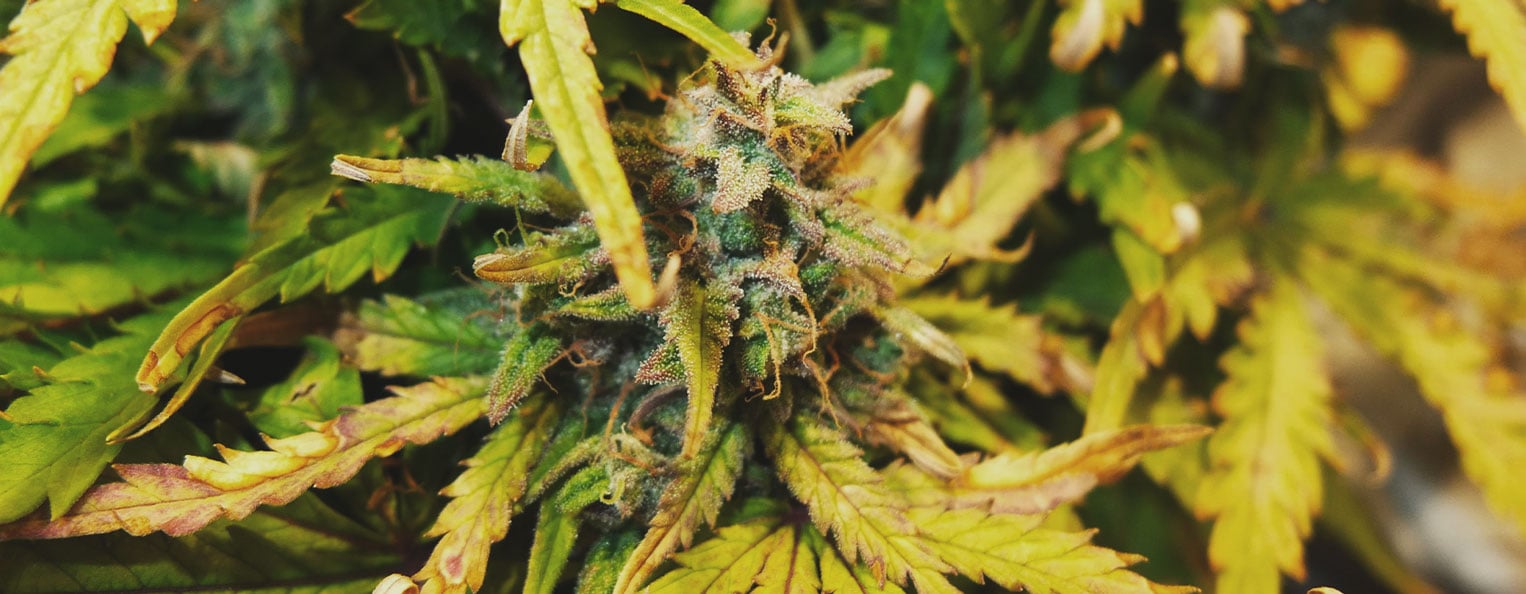
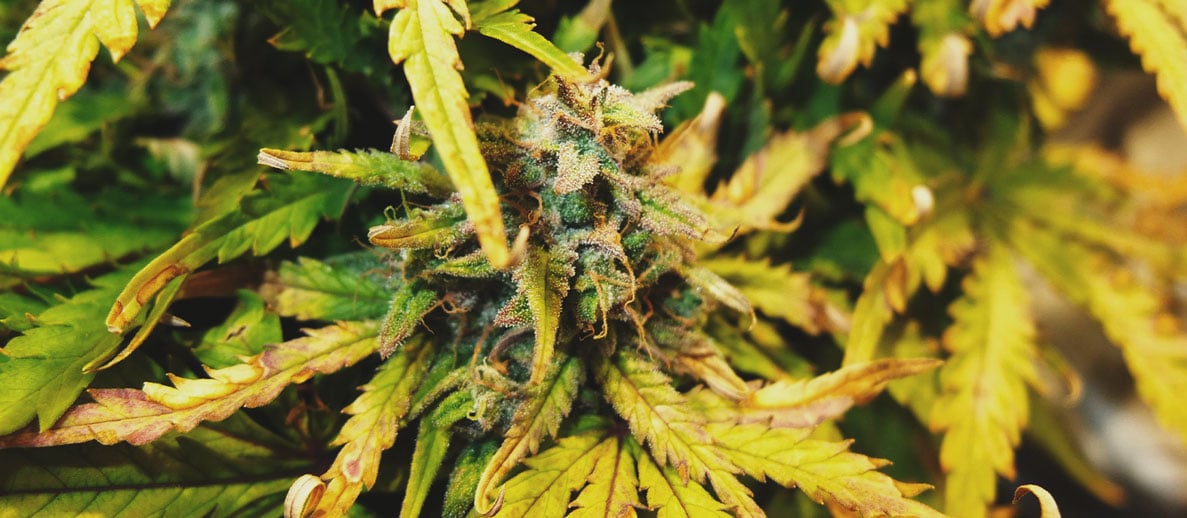
| How to prevent |
|
| How to fix |
|
| How to prevent |
|
| How to fix |
|
OVERWATERING
When cannabis is overwatered, it can lead to all kinds of growing problems. The roots suffocate and can’t access oxygen that the plant needs, and mould, fungus, and pests are more likely to appear. Many times, the leaves will turn yellow during the later stages of continued overwatering.
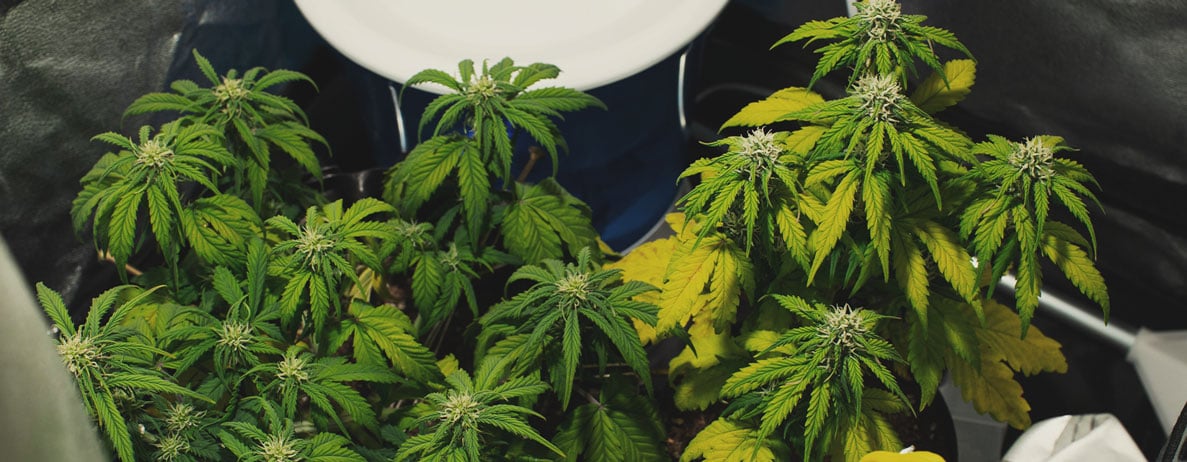
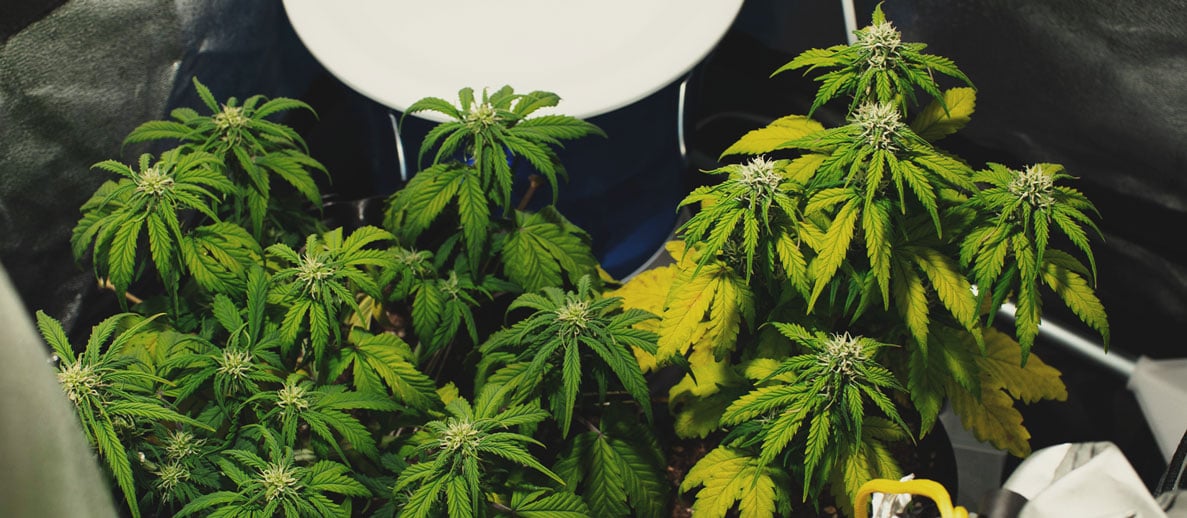
| How to prevent |
|
| How to fix |
|
| How to prevent |
|
| How to fix |
|
NUTRIENT DEFICIENCIES
Nutrient deficiencies, nitrogen deficiency in particular, are one of the most common reasons leaves turn yellow. When lacking in the substrate, the plant draws nutrients from the leaves, turning them yellow in the process.
Know that a nutrient deficiency doesn’t necessarily mean you aren’t feeding your plants enough. Many times, a nutrient deficiency is rooted in incorrect water pH levels, or even from overfeeding. When the plant cannot access nutrients, even if they are present, this is known as nutrient lockout.
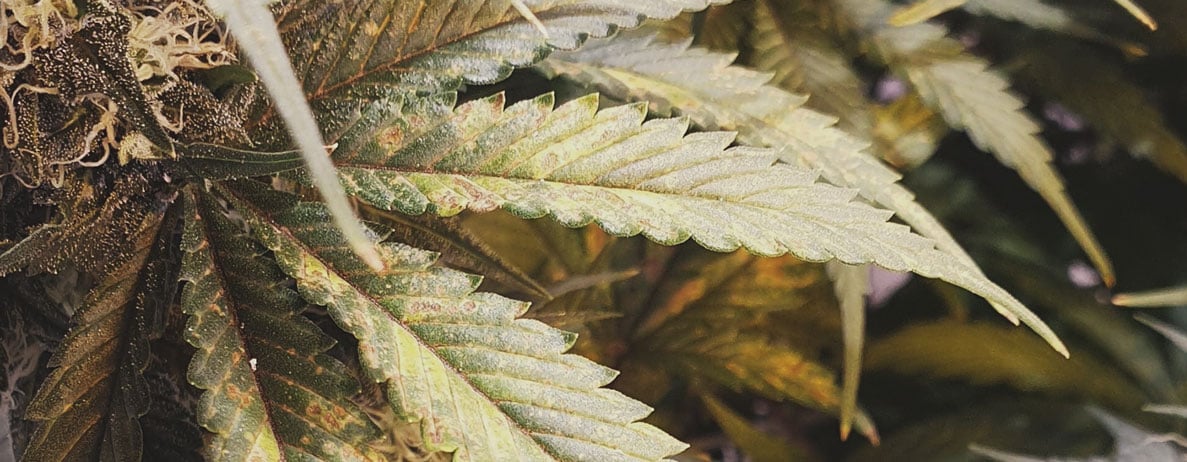
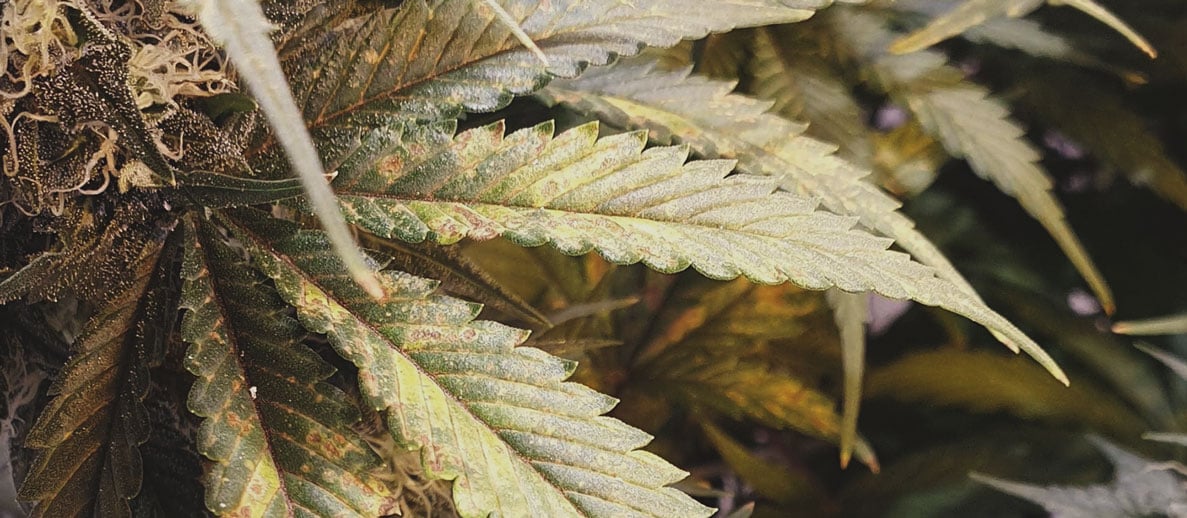
| How to prevent |
|
| How to fix |
|
| How to prevent |
|
| How to fix |
|
PESTS
Common pests, such as fungus gnats or mites, can lead to cannabis leaves turning yellow. Make sure you know which is on your plants, though, as they cause different issues and require different solutions.
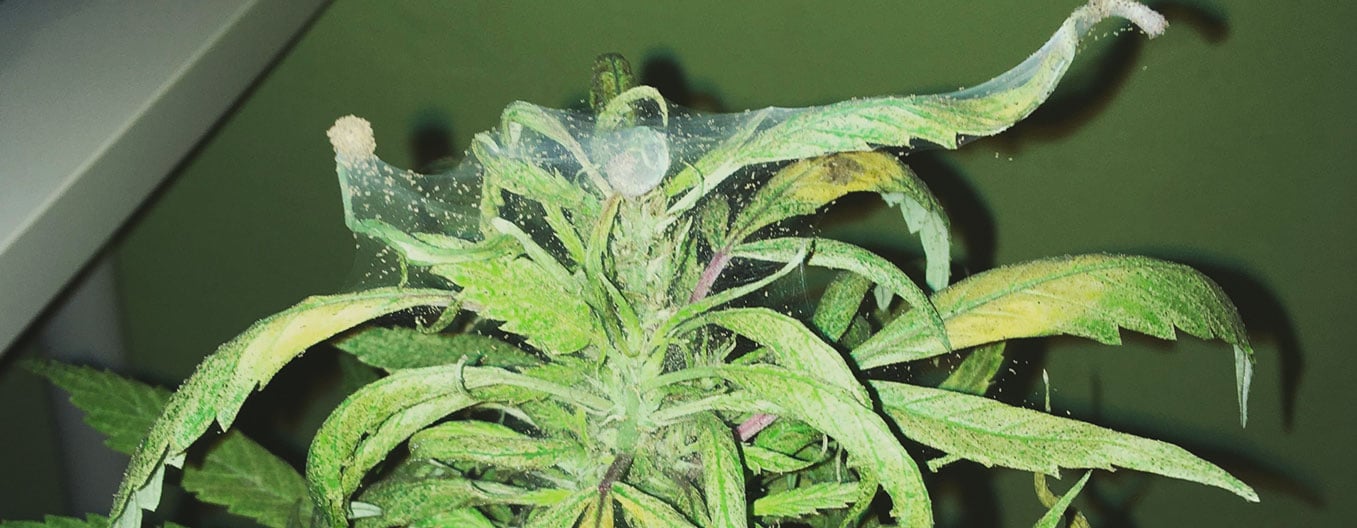
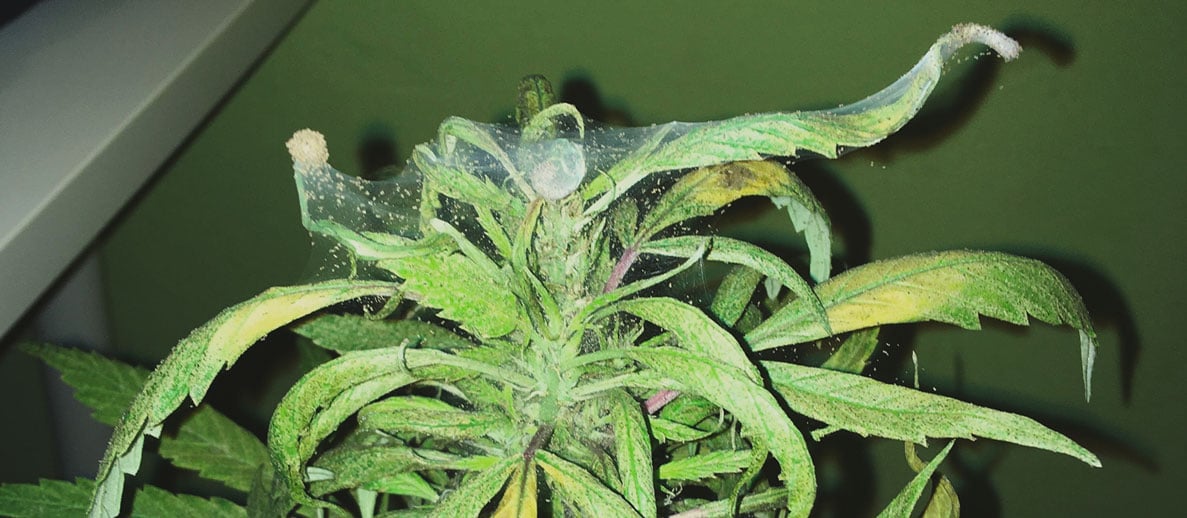
| How to prevent |
|
| How to fix |
|
| How to prevent |
|
| How to fix |
|
ROOT ROT
Root rot, as you can tell from the name, is a serious condition that affects the foundation of your cannabis plant. Most of the time, it is caused by a lack of oxygen in the root zone due to overwatering. High humidity and temperatures in the grow room could also be causes for root rot, along with contamination of the growing area (or water reservoir) by harmful bacteria or fungus.
When leaves turn yellow from root rot, it will usually take some time to manifest fully. It may present itself as large, irregular yellow patches, or it may only affect the edges. Leaves will also crumble and wilt at the same time.
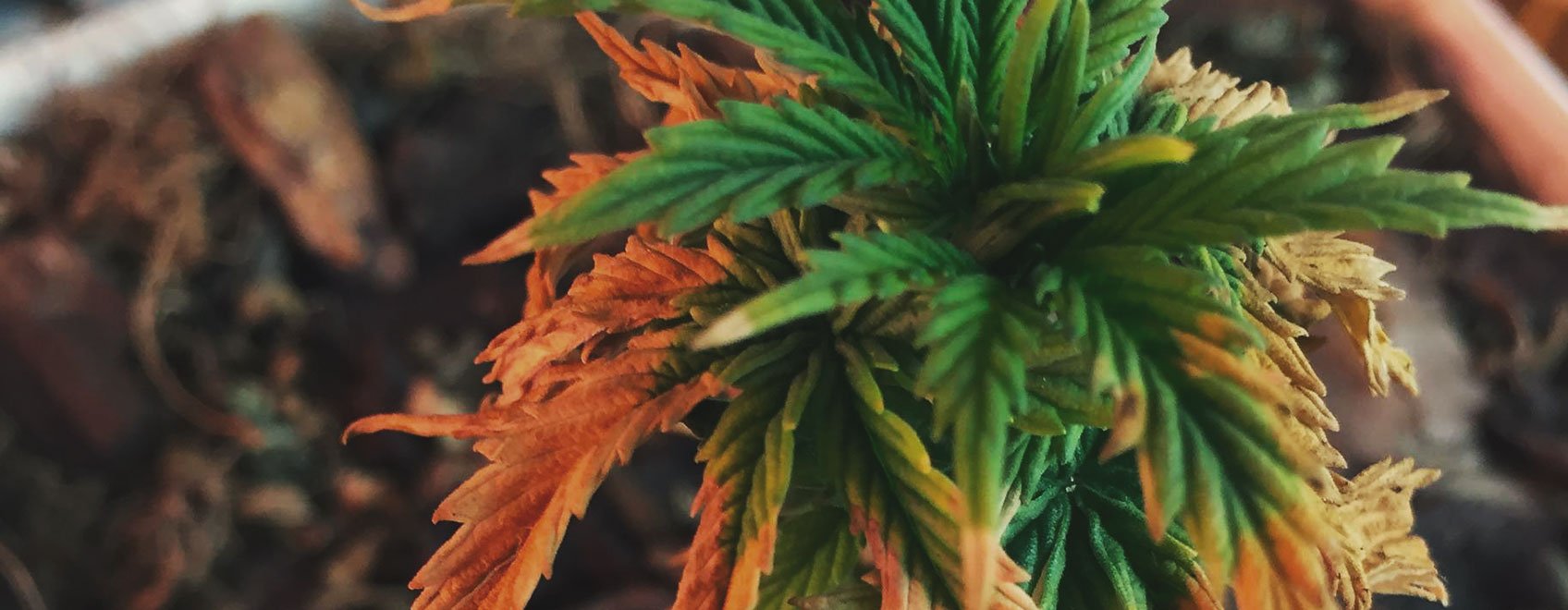
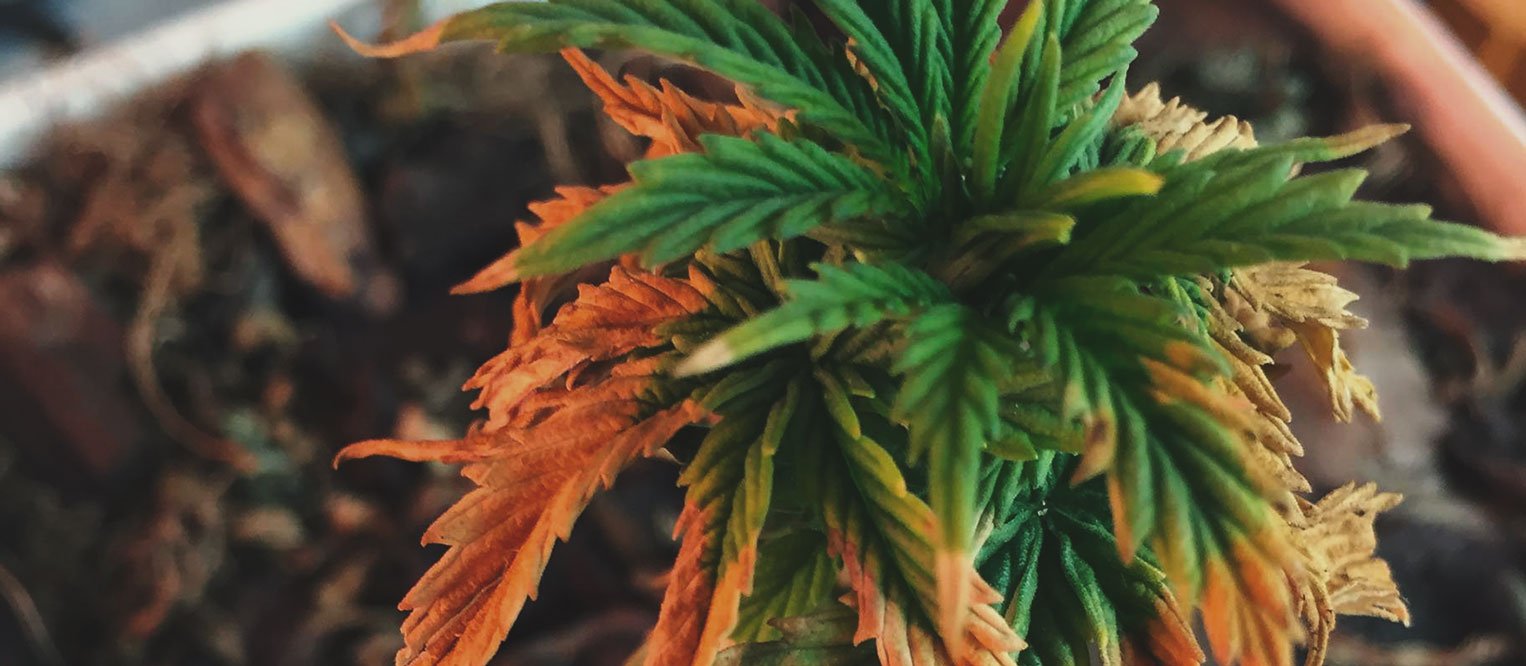
| How to prevent |
|
| How to fix |
|
| How to prevent |
|
| How to fix |
|
PH FLUCTUATIONS
Sometimes, as we mentioned before, yellow leaves can be a result of pH fluctuations around the roots of your cannabis plant. This will stress out the plant and cause spots to appear. Most of the time, the yellowish, brownish part will be in the middle of lower, older leaves.
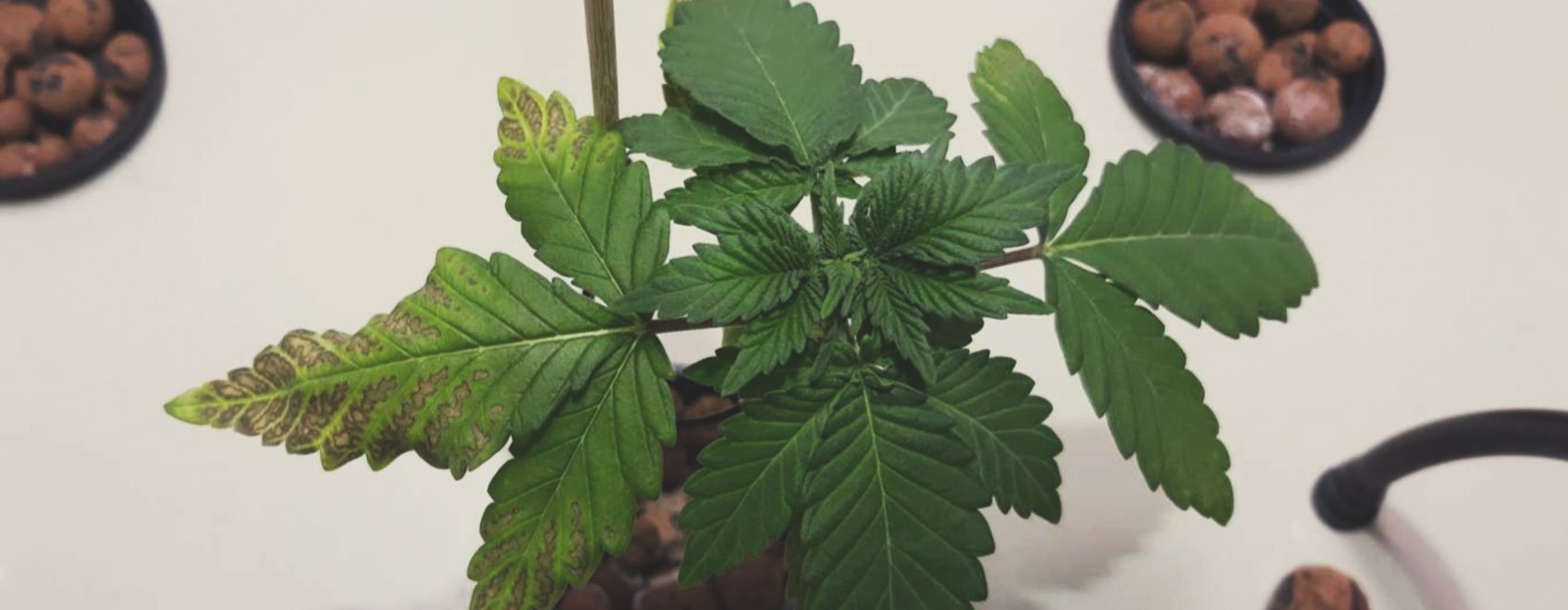
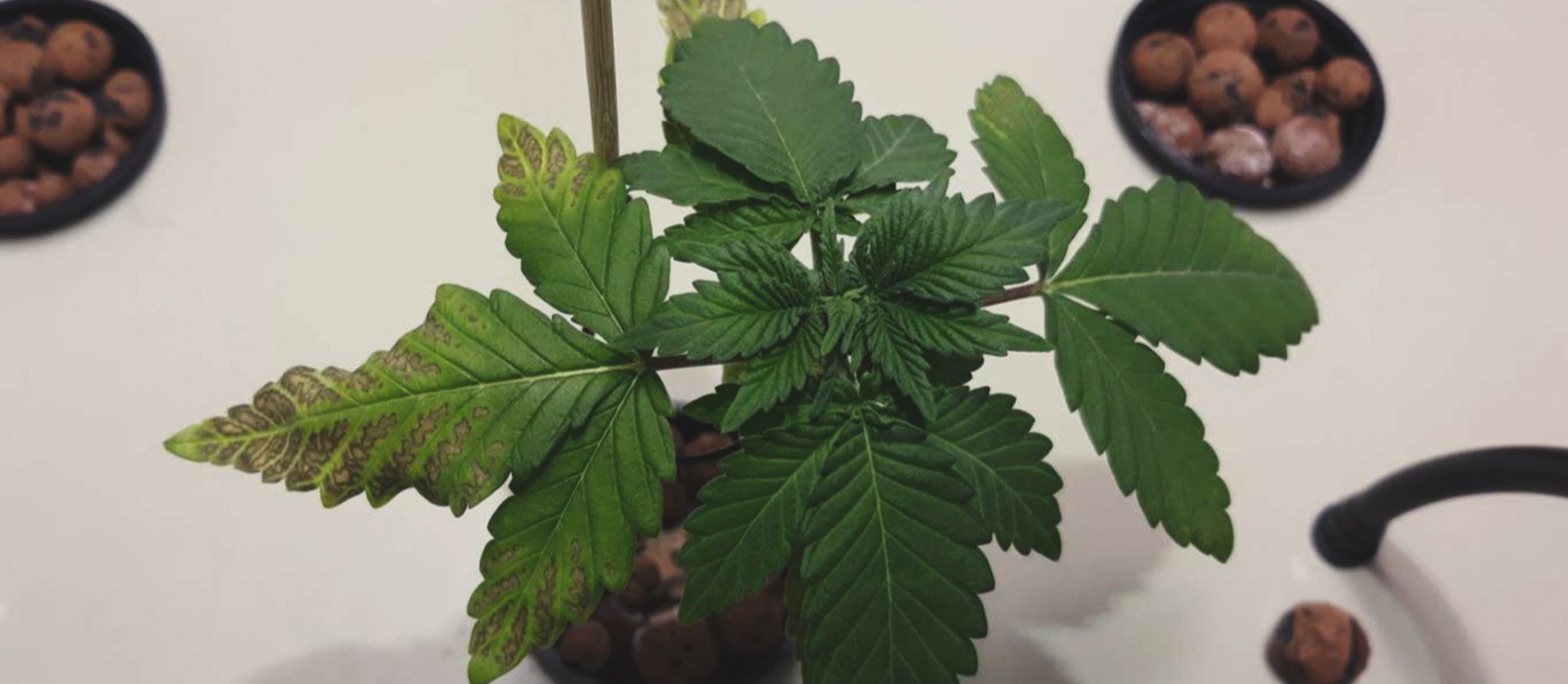
| How to prevent |
|
| How to fix |
|
| How to prevent |
|
| How to fix |
|
LEAF SEPTORIA
Leaf septoria, also known as septoria leaf spot or yellow leaf spot, shows as yellow-brown spots on the upper and lower sides of the leaves. It is a fungal disease brought on by spores, and is particularly prevalent in wet and humid conditions.
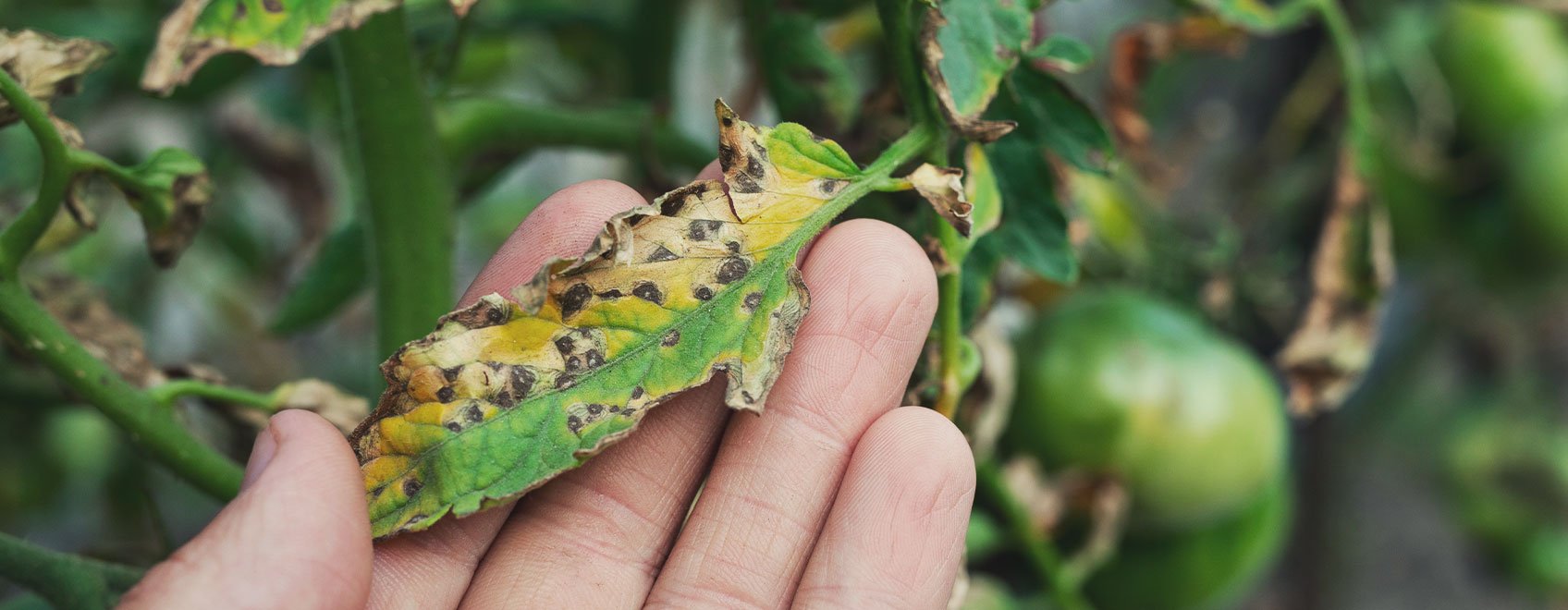
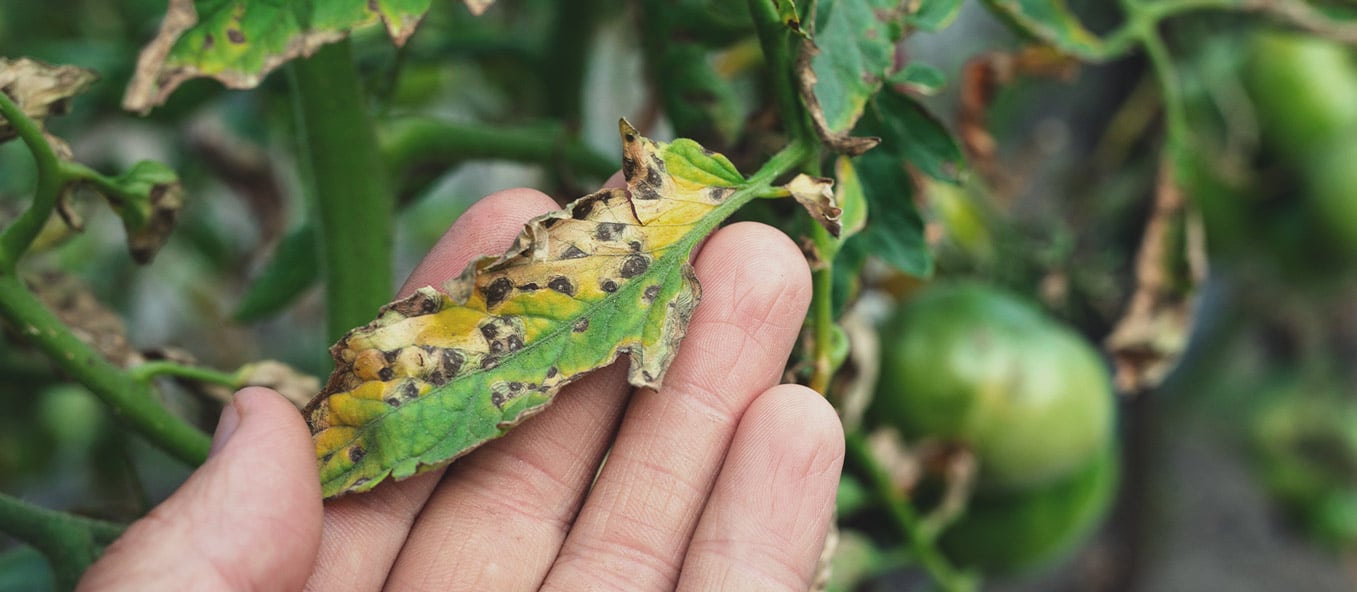
| How to prevent |
|
| How to fix |
|
| How to prevent |
|
| How to fix |
|
Curly leaves
The leaves of your cannabis can curl for a variety of reasons. They may bend downwards or upwards, roll up on the edges, or curl and crumble in irregular ways. These are the most common causes of curly leaves:
HEAT STRESS
Heat can dry out the leaves and make them curl. In a typical indoor grow setting, heat stress is due to plants being too close to the grow lights.
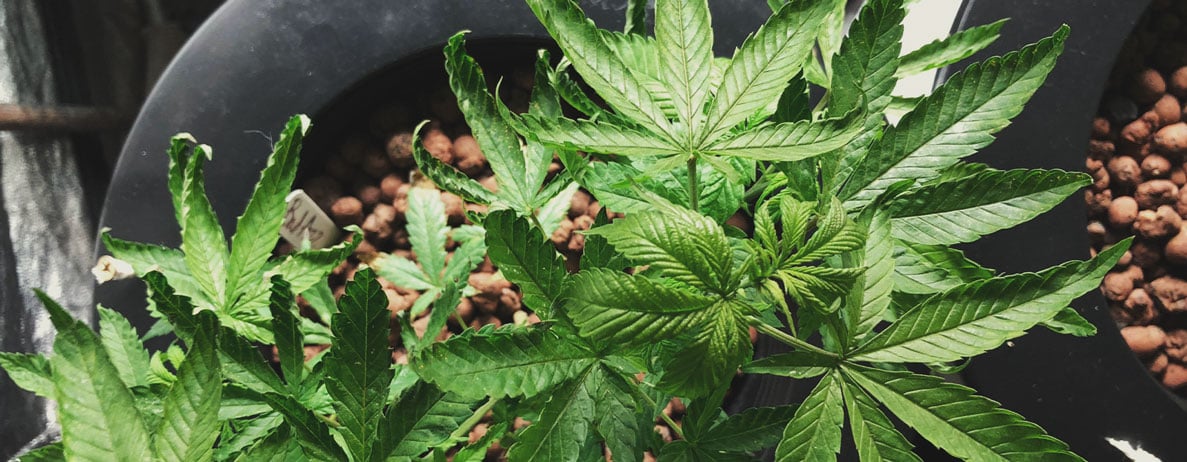
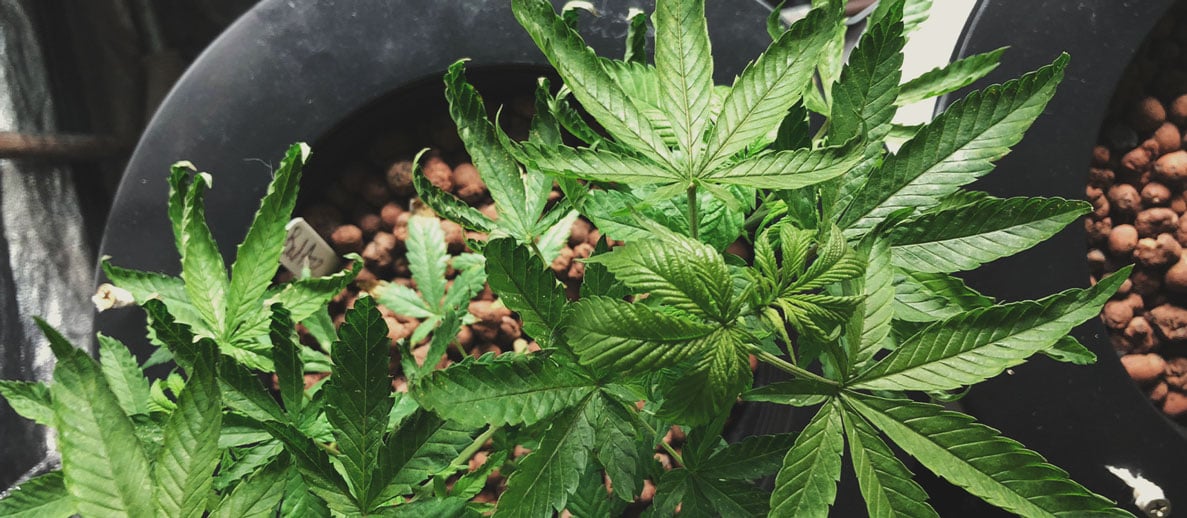
| How to prevent |
|
| How to fix |
|
| How to prevent |
|
| How to fix |
|
OVERWATERING
When leaves curl due to overwatering, your weed plant will take on a “heavy” appearance, as if something is bogging it down. The leaves will bend downward in an arc and make an “eagle claw”.
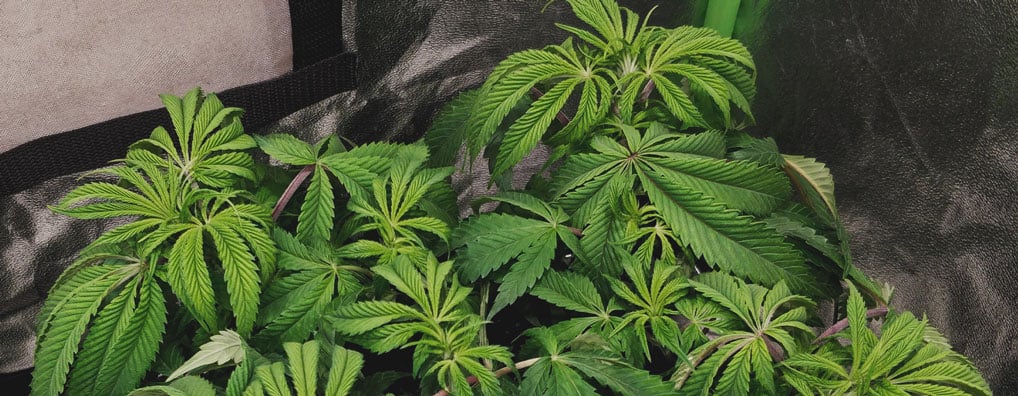
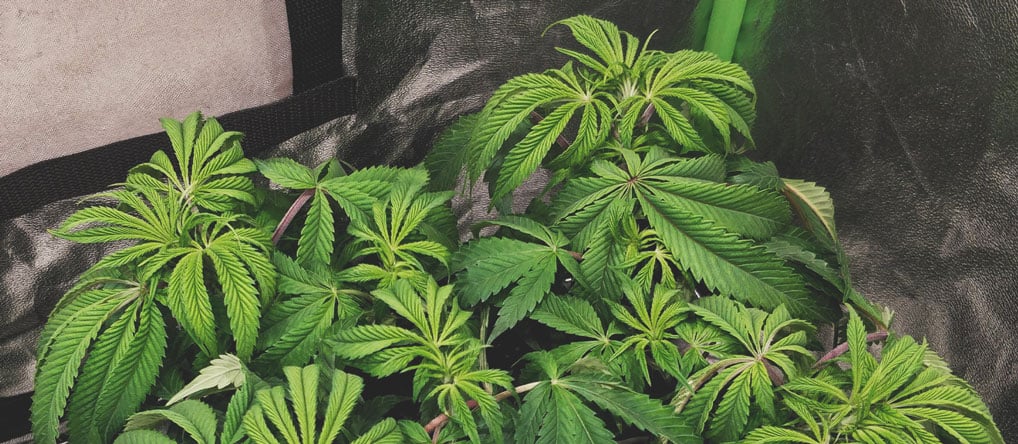
| How to prevent |
|
| How to fix |
|
| How to prevent |
|
| How to fix |
|
OVER-FERTILISATION
The first sign of overfeeding, or nutrient burn, is a tiny crispy tip on the leaves. If overfeeding continues, the entire leaf will turn crispy and brown in turn.
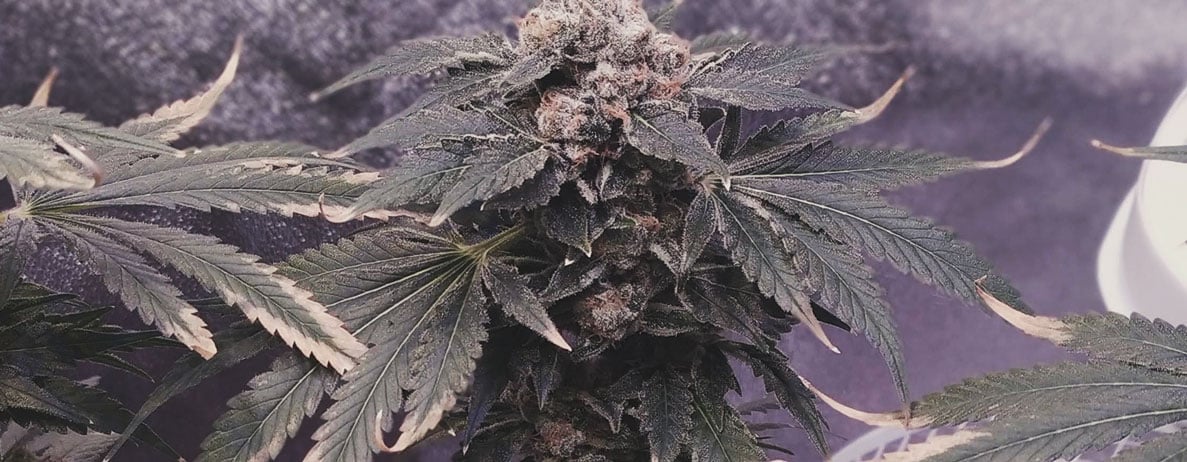
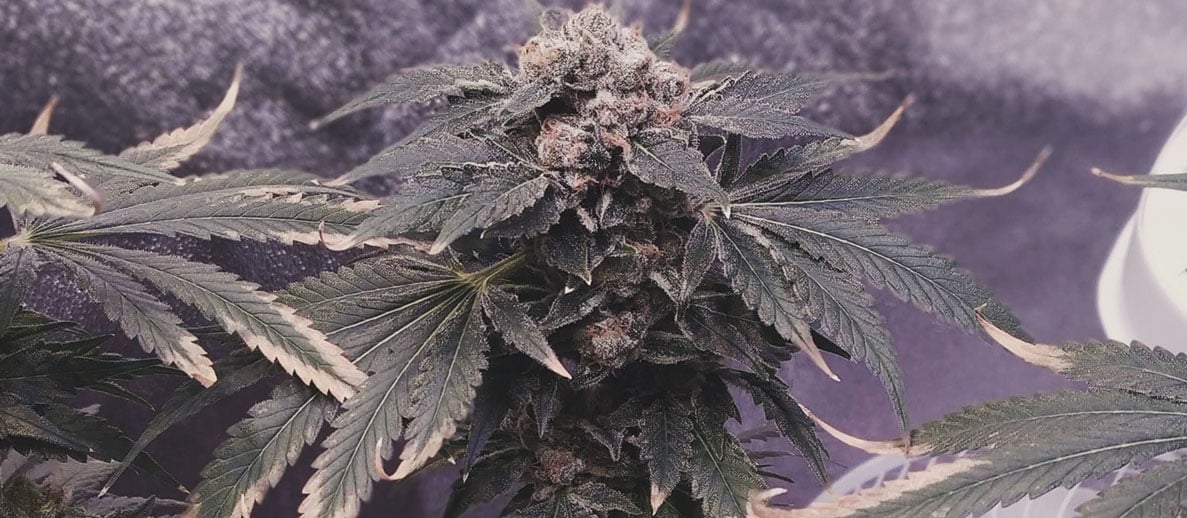
| How to prevent |
|
| How to fix |
|
| How to prevent |
|
| How to fix |
|
COLD
Sometimes cannabis leaves can curl due to cold temperatures.
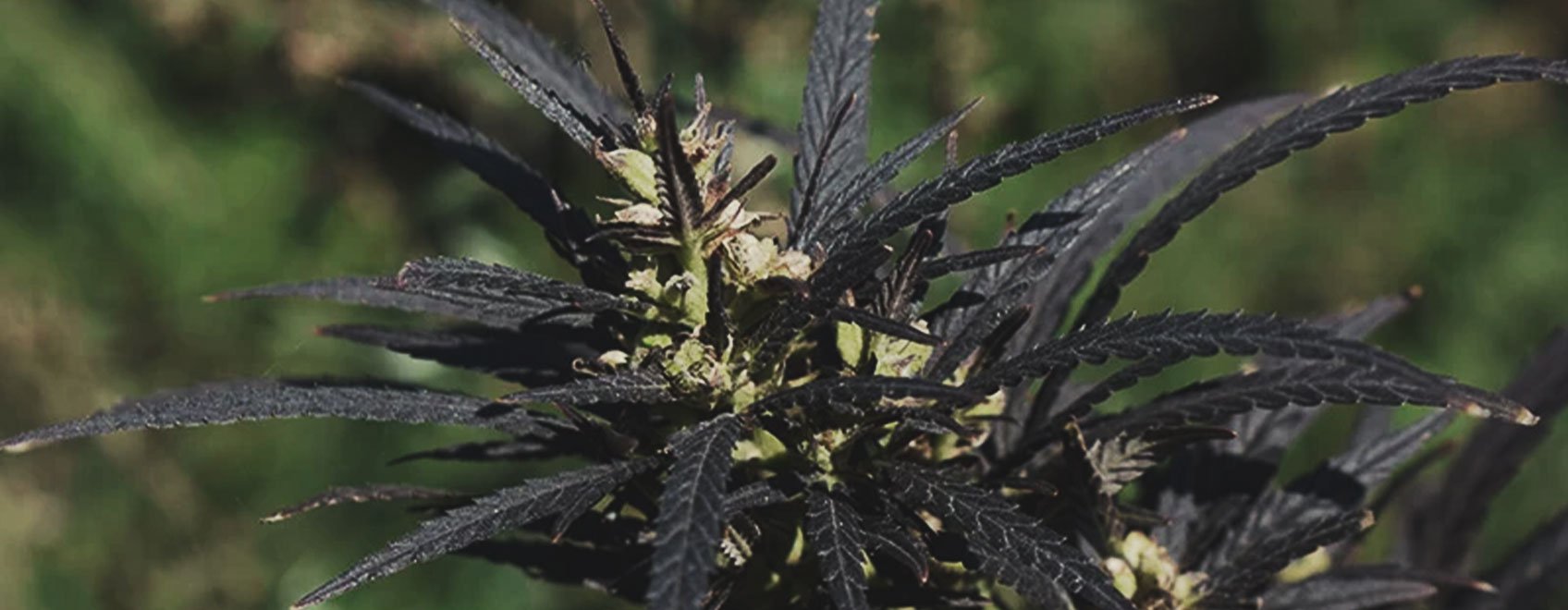
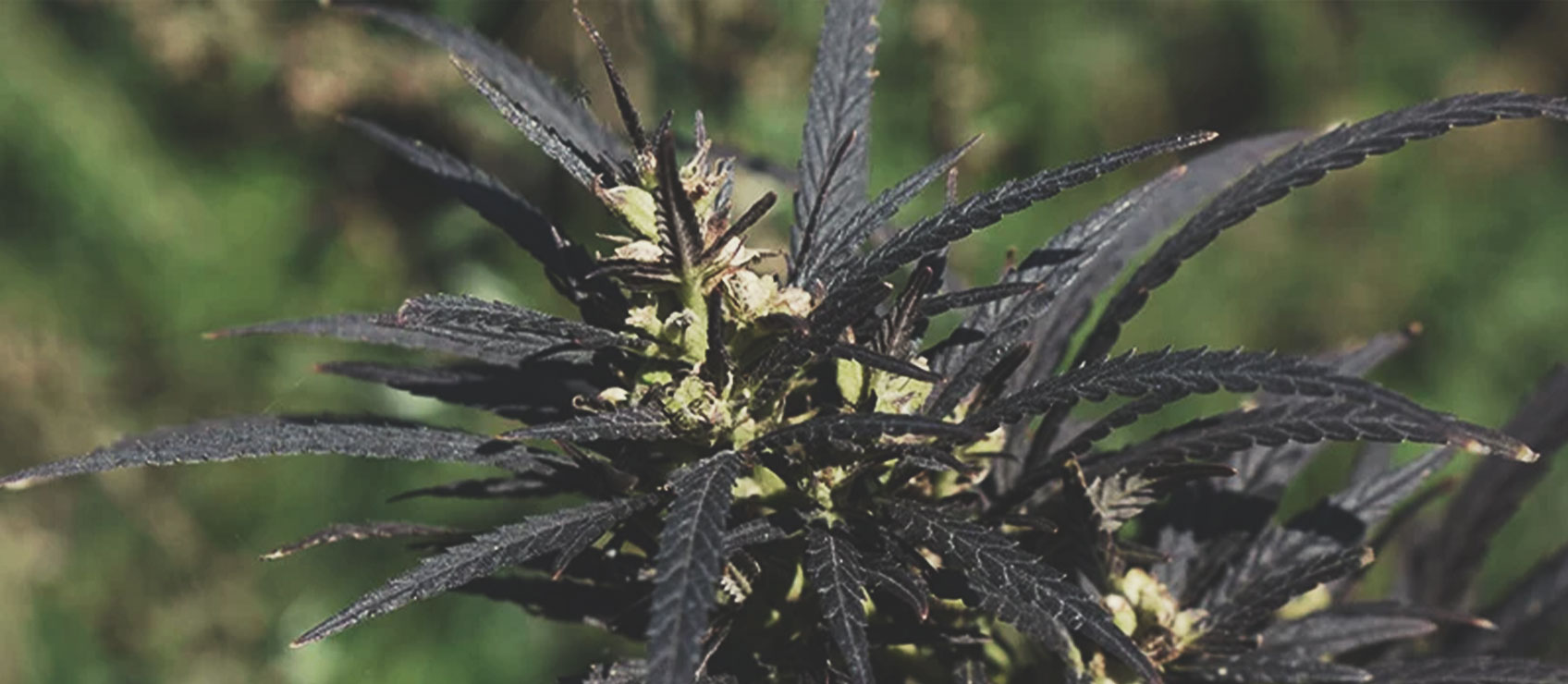
| How to prevent |
|
| How to fix |
|
| How to prevent |
|
| How to fix |
|
Dry and crispy
In certain cases, if your plant goes without adjustments after the leaves start to curl, they could start to get dry and crispy. As many owners of house plants know, this is a sign that immediate treatment is needed.
HEAT STRESS
As we mentioned before, this usually just means your plants are too close to your grow lights. However, heat stress can also occur if you’re growing outdoors, or in a greenhouse in hot temperatures. The leaves, as we’ll discuss in a bit, can get dry and crispy in the late stages of heat stress.
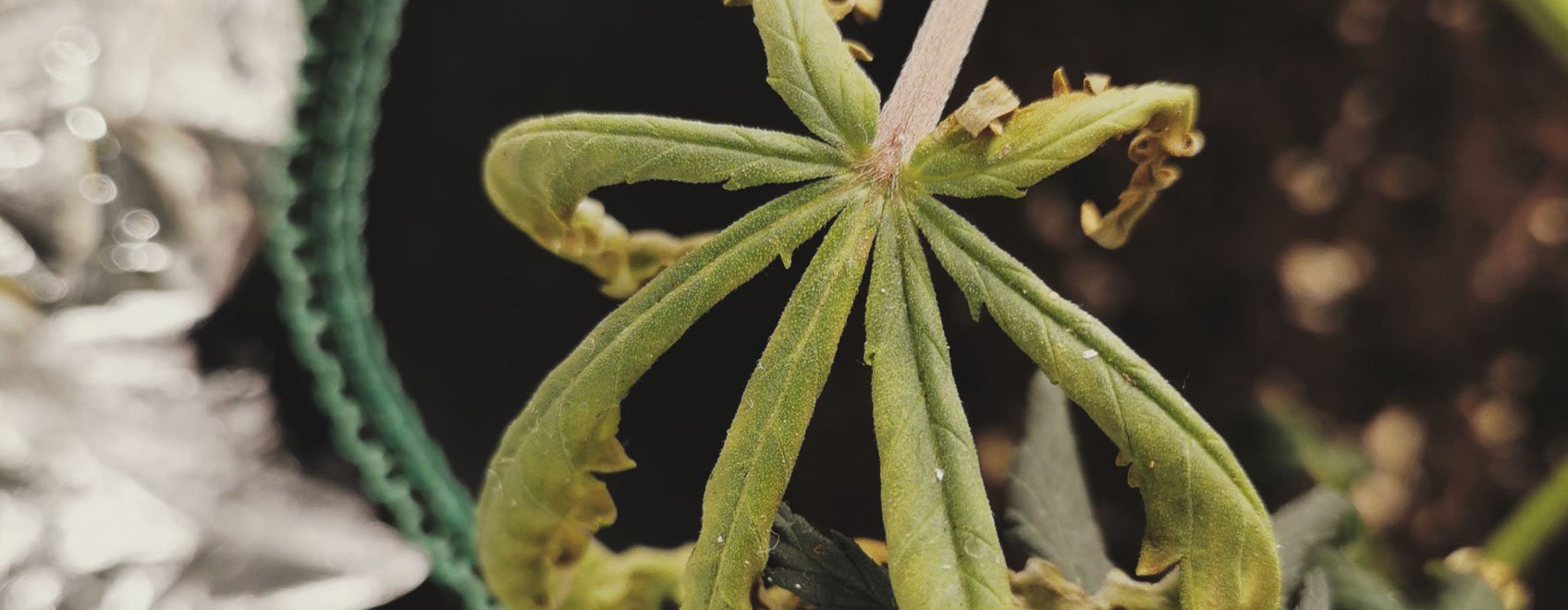
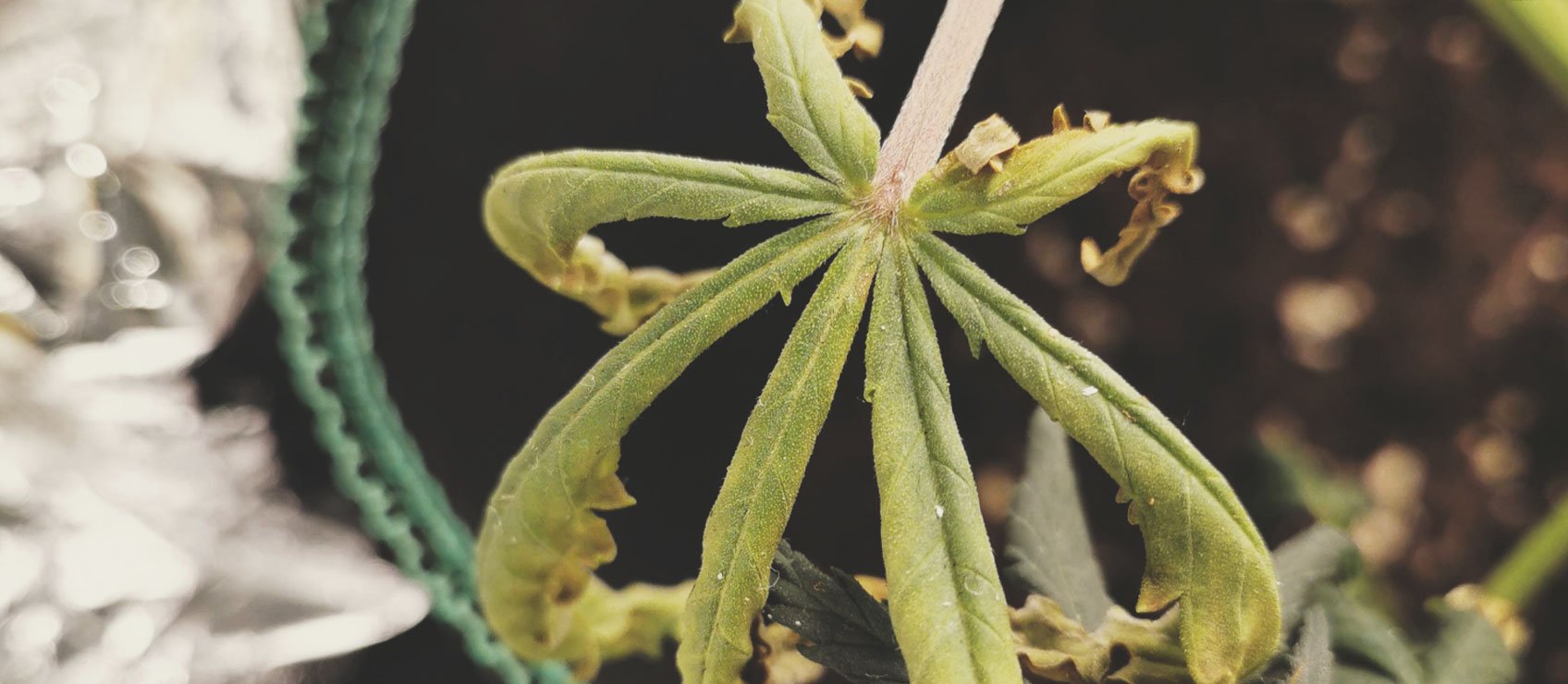
| How to prevent |
|
| How to fix |
|
| How to prevent |
|
| How to fix |
|
LIGHT BURN
Light burn is often preceded by bleaching, during which the leaves turn white. Sometimes, however, light burn has already occurred by the time bleaching starts. If light and heat issues aren’t addressed, the leaves will become crispy and die. This one is rather easy to spot, as light burn typically appears on the leaves closest to the light source.
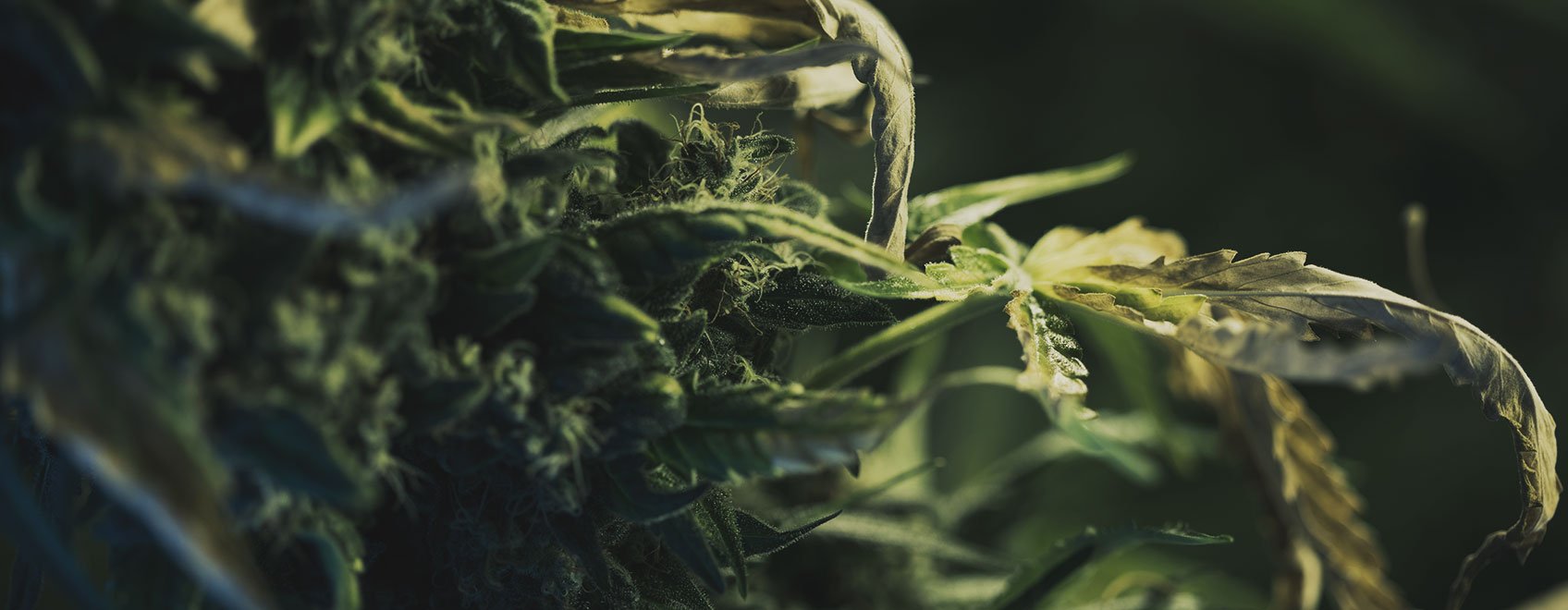
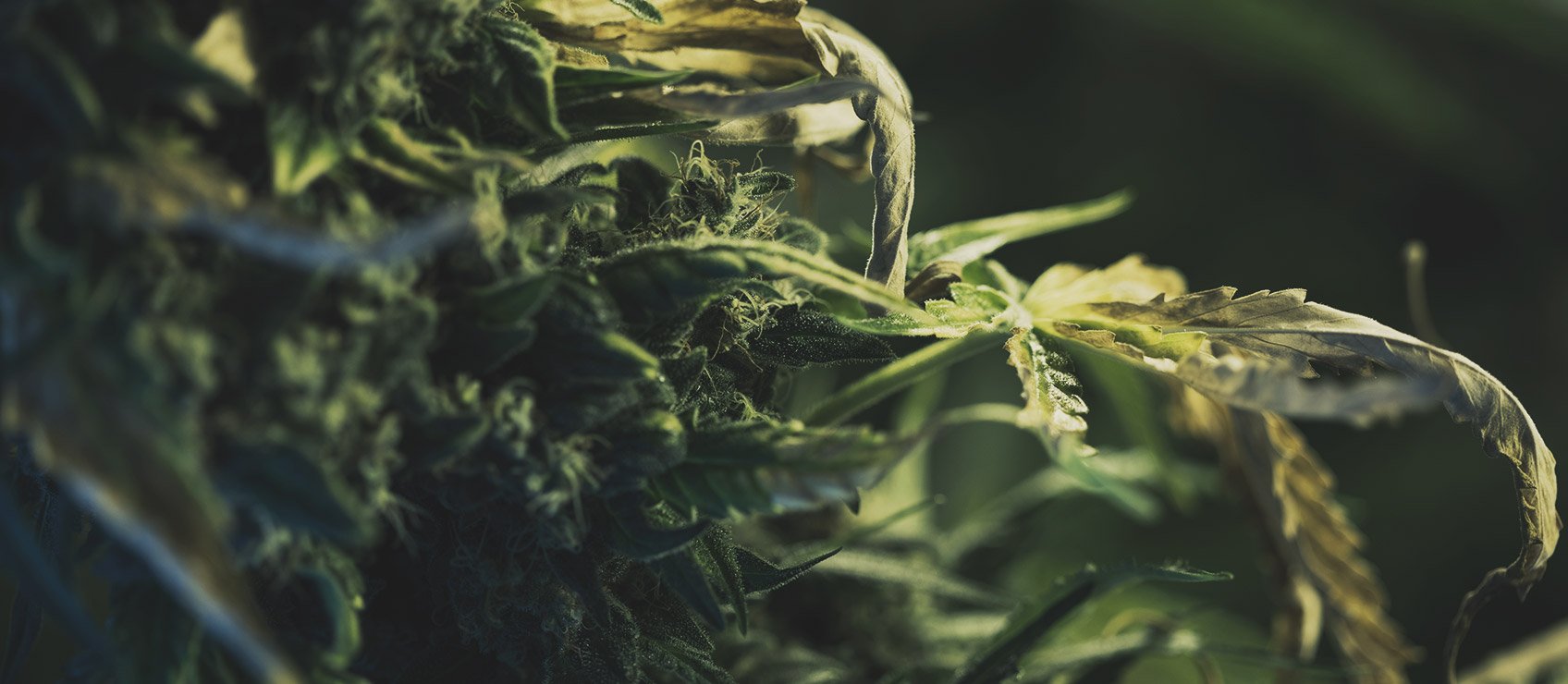
| How to prevent |
|
| How to fix |
|
| How to prevent |
|
| How to fix |
|
OVER-FERTILISATION
Starting with dried-out leaf tips, prolonged nutrient burn will manifest as whole leaves becoming dry and crispy. This is the last stage of over-fertilisation. The leaves, and therefore your cannabis plant, are dying. That doesn’t mean you can’t save them, though.
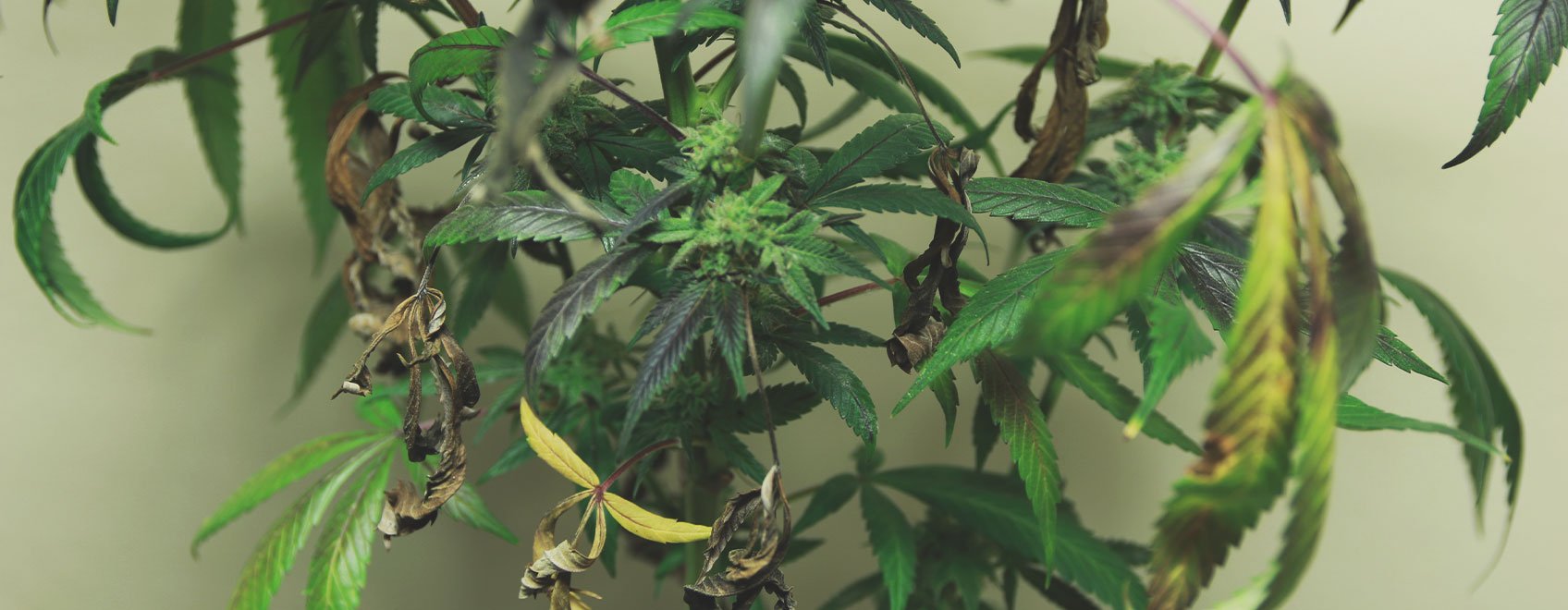
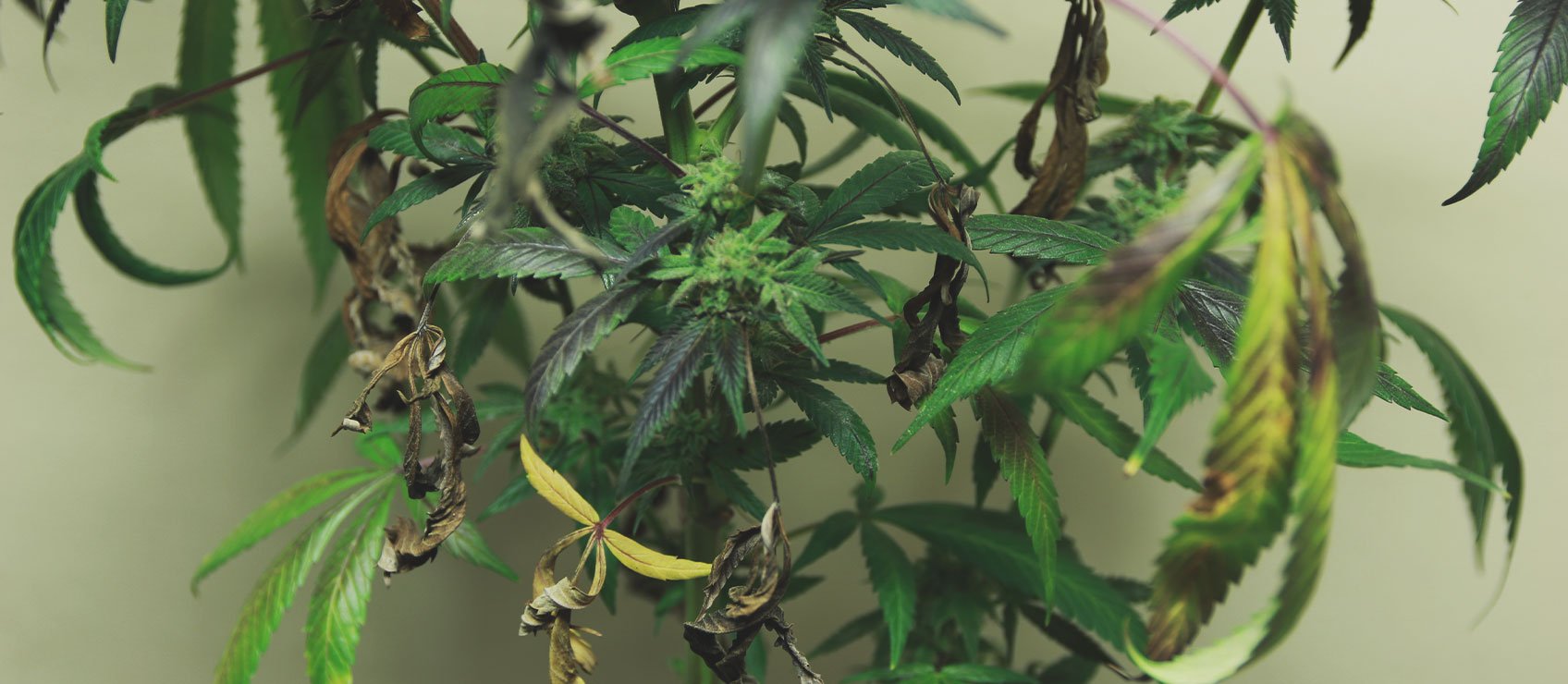
| How to prevent |
|
| How to fix |
|
| How to prevent |
|
| How to fix |
|
Wilting leaves
Wilting leaves, just like discoloured and spotted leaves, can be caused by many things. Here are the most common issues cultivators should be aware of:
UNDERWATERING
The main sign of underwatering is a drooping plant with wilting leaves and branches. If the plant doesn’t get water after that point, the leaves will start to dry out.
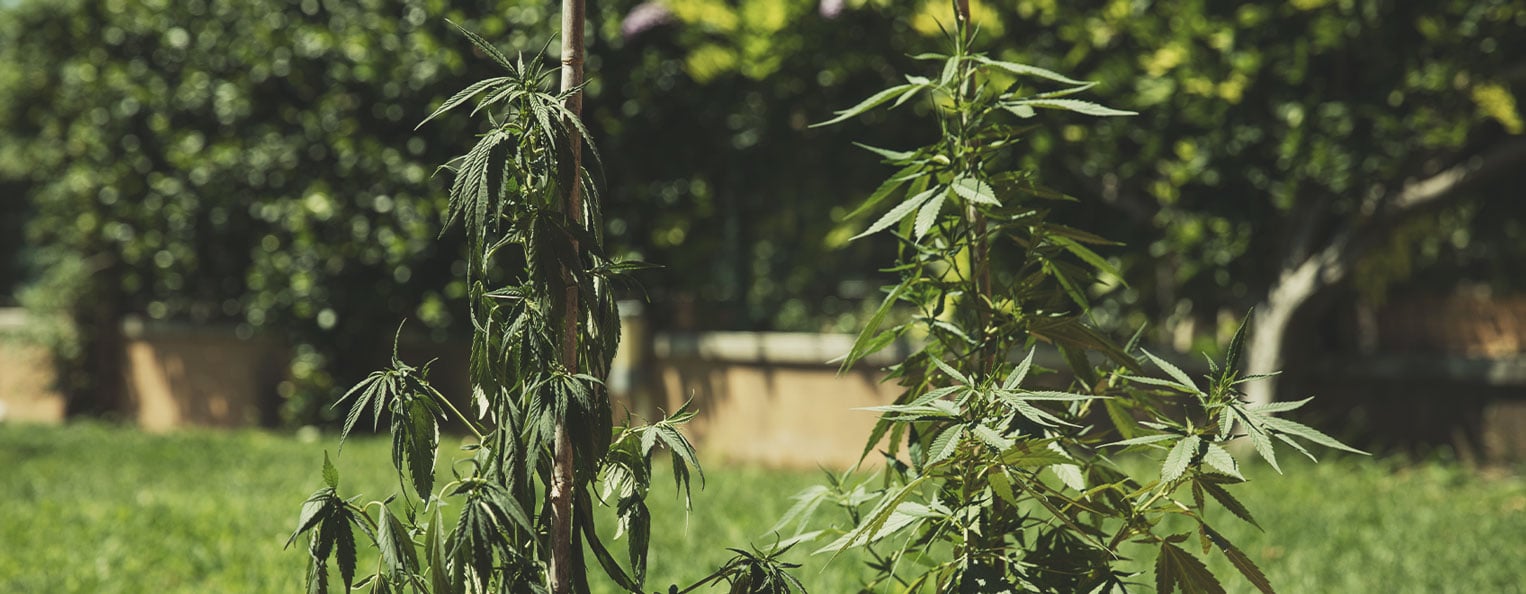
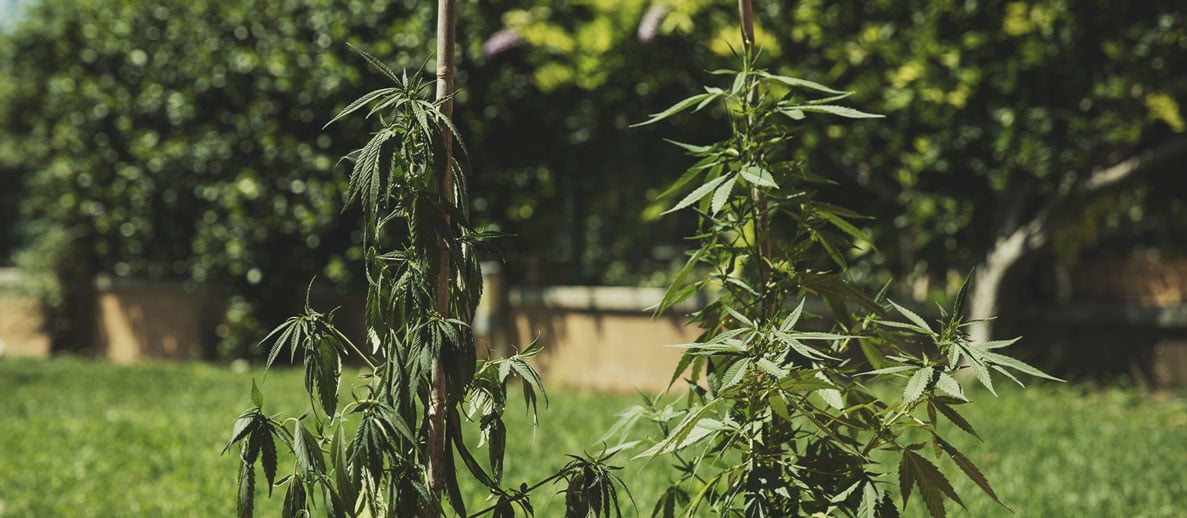
| How to prevent |
|
| How to fix |
|
| How to prevent |
|
| How to fix |
|
WIND BURN
This is more of an issue if you’re growing outdoors with your plant exposed to the elements. However, it can also happen indoors when your plants are too close to a powerful fan.
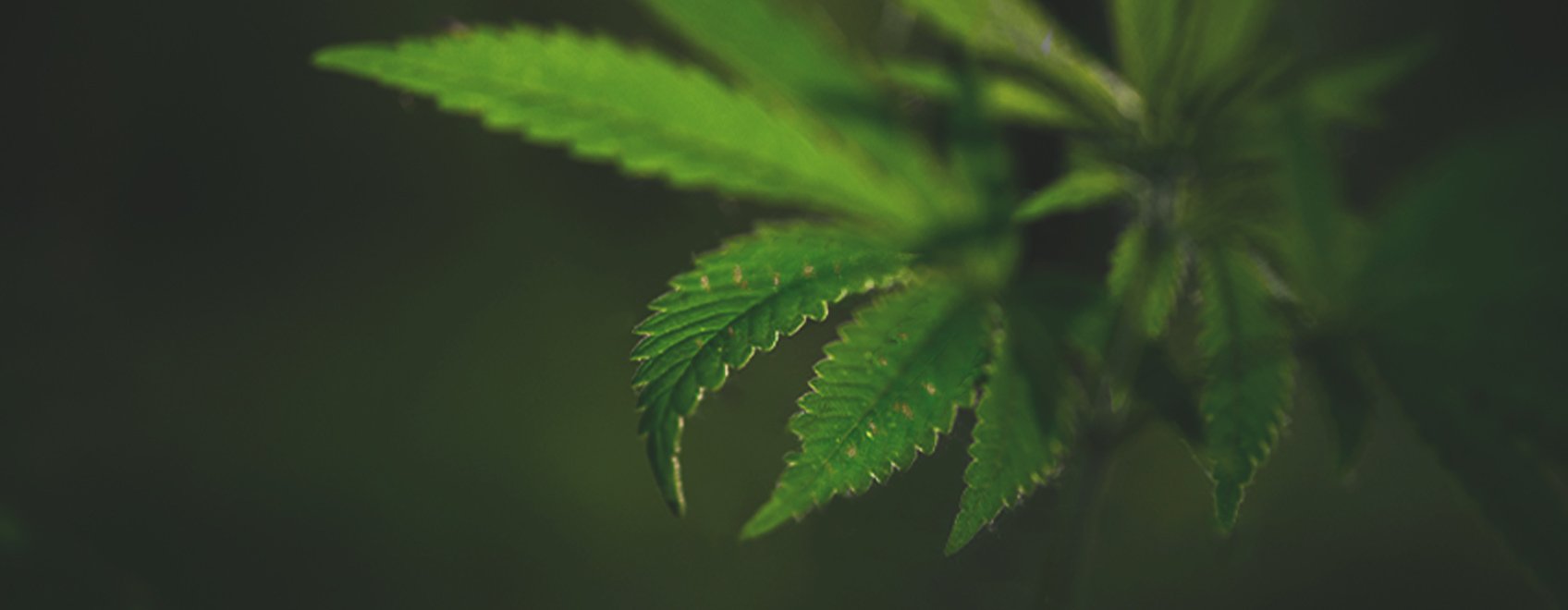
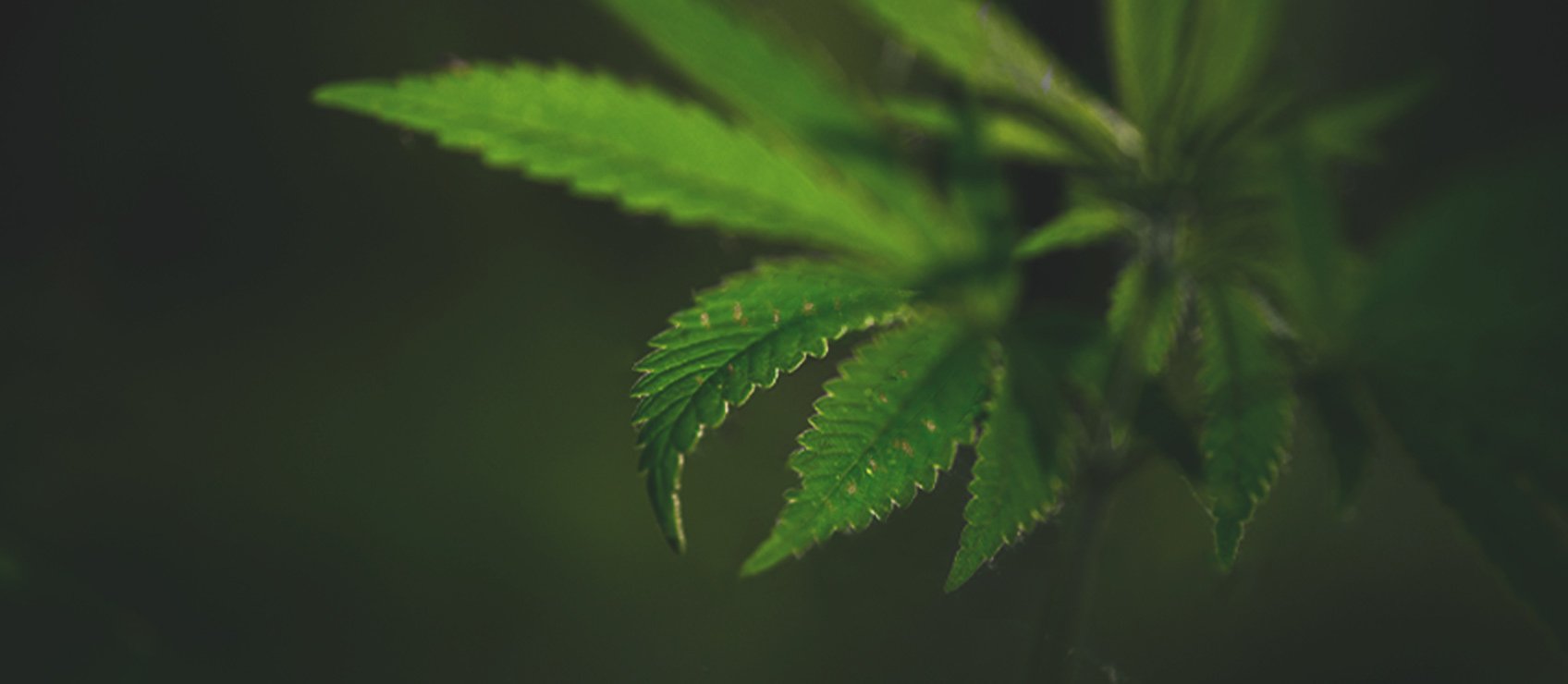
| How to prevent |
|
| How to fix |
|
| How to prevent |
|
| How to fix |
|
VERTICILLIUM
Verticillium wilt is a serious condition caused by fungus that can reside in soil. In short, it attacks the roots of your cannabis, leaving them near death with no possible cure. It presents as a yellowing and shrivelling of the lower leaves, followed by parts of the plant suddenly wilting. The best thing you can do is start with preventative measures; that way, it doesn’t have a chance to devastate your crop.
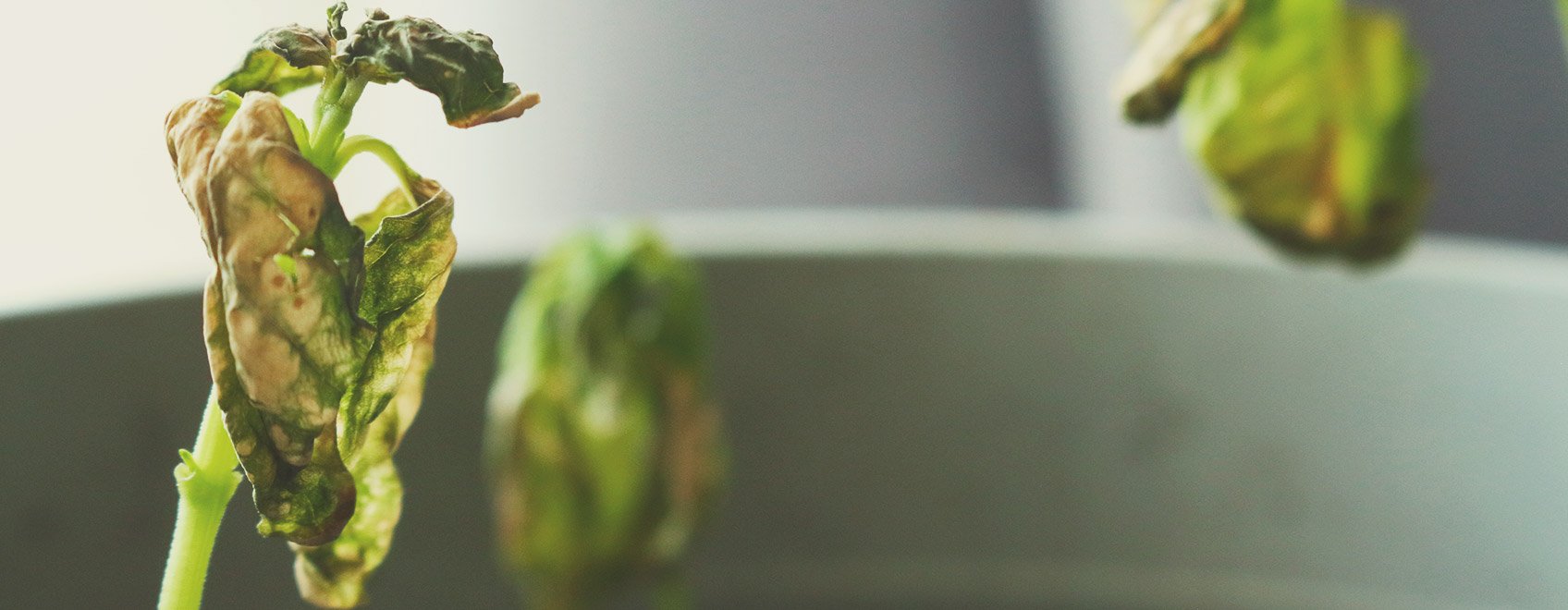
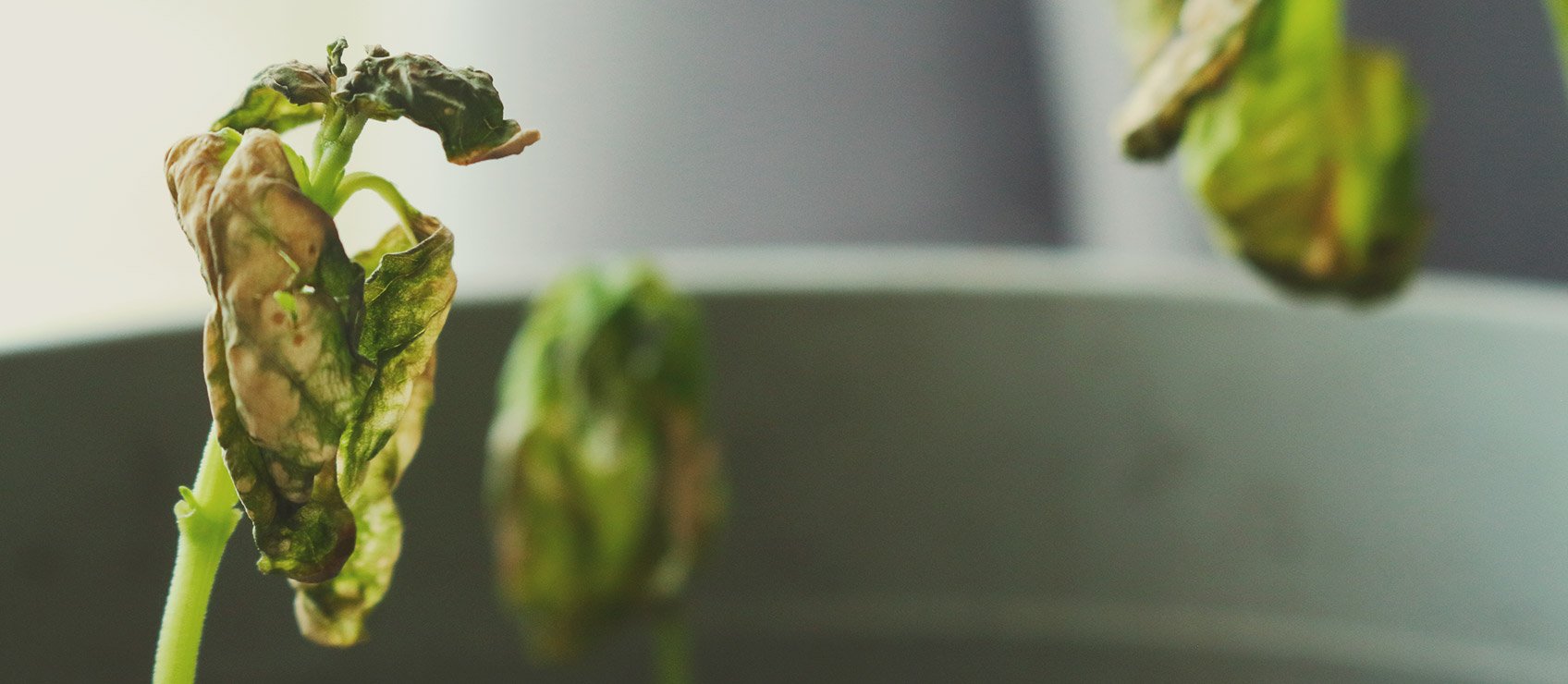
| How to prevent |
|
| How to fix |
|
| How to prevent |
|
| How to fix |
|
Coloured leaves
Cannabis leaves usually come in shades of green, ranging from light lime green to deeper forest hues. Sometimes, though, they can also turn other colours, depending on the strain and certain environmental factors. In most cases, you have no need to worry! These colours add to the bag appeal of a strain and are highly prized by cannabis enthusiasts.
However, there are some cases where leaves turning a different colour may be a sign of a serious problem.
NITROGEN TOXICITY
Overfeeding can cause various changes to the leaves, but nitrogen toxicity specifically will turn the leaves a very dark green. This could happen if you use a fertiliser with ample nitrogen for the vegetative phase and forget to switch it out during flowering.
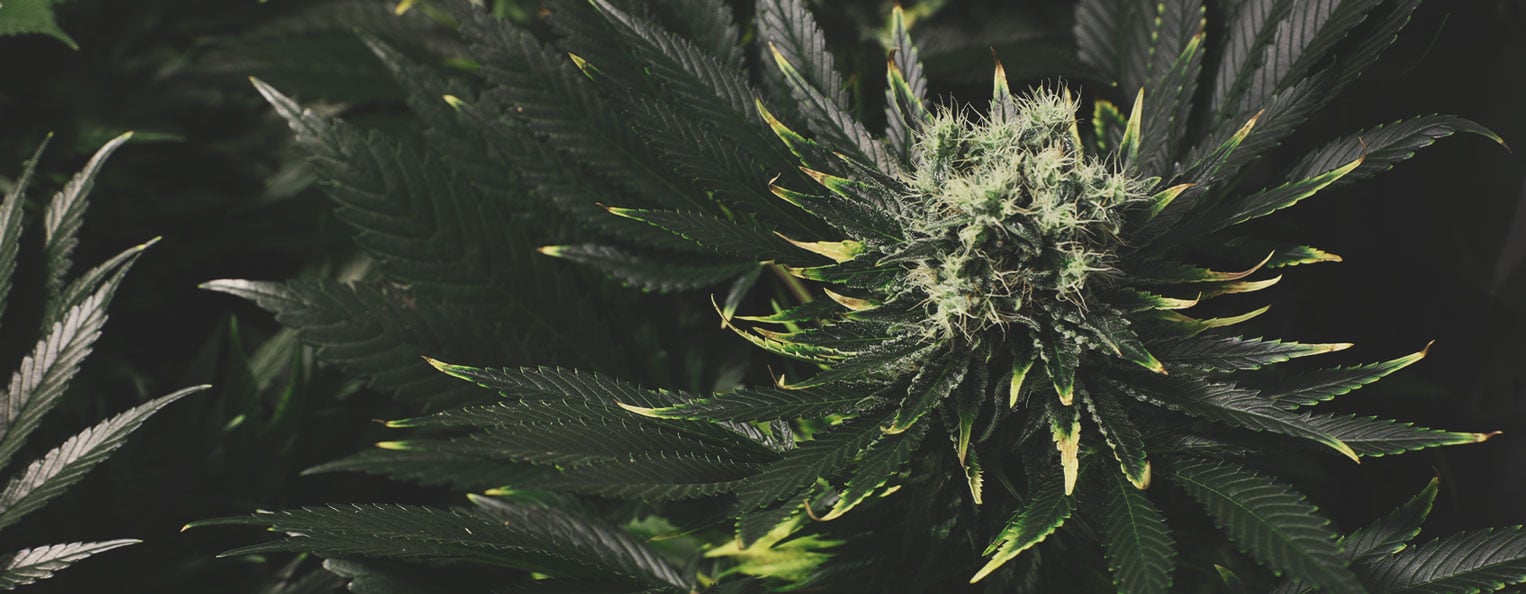
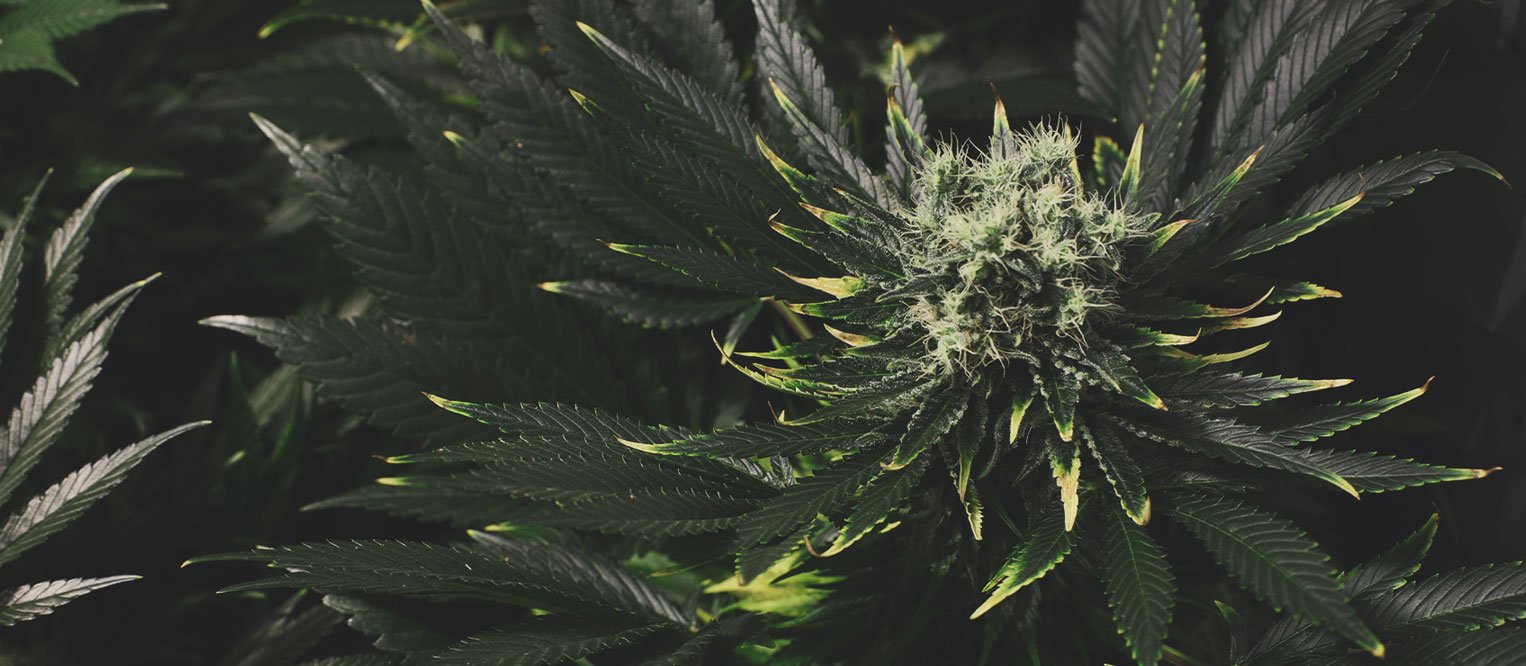
| How to prevent |
|
| How to fix |
|
| How to prevent |
|
| How to fix |
|
PURPLE LEAVES ARE OK
Reddish and purple leaves are usually nothing to worry about. In fact, some strains are bred to display beautiful purple leaves and buds. Some strains may show the usual green colours at first, but can turn red or purple with colder night time temperatures.
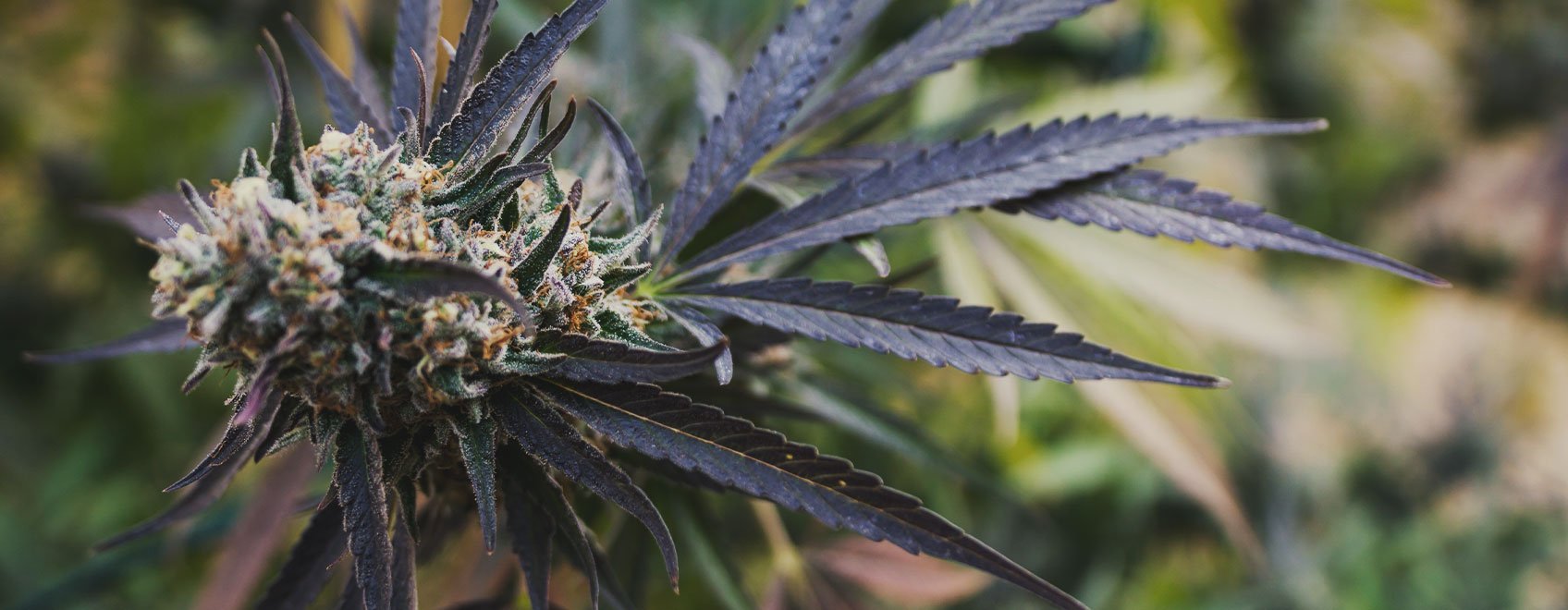
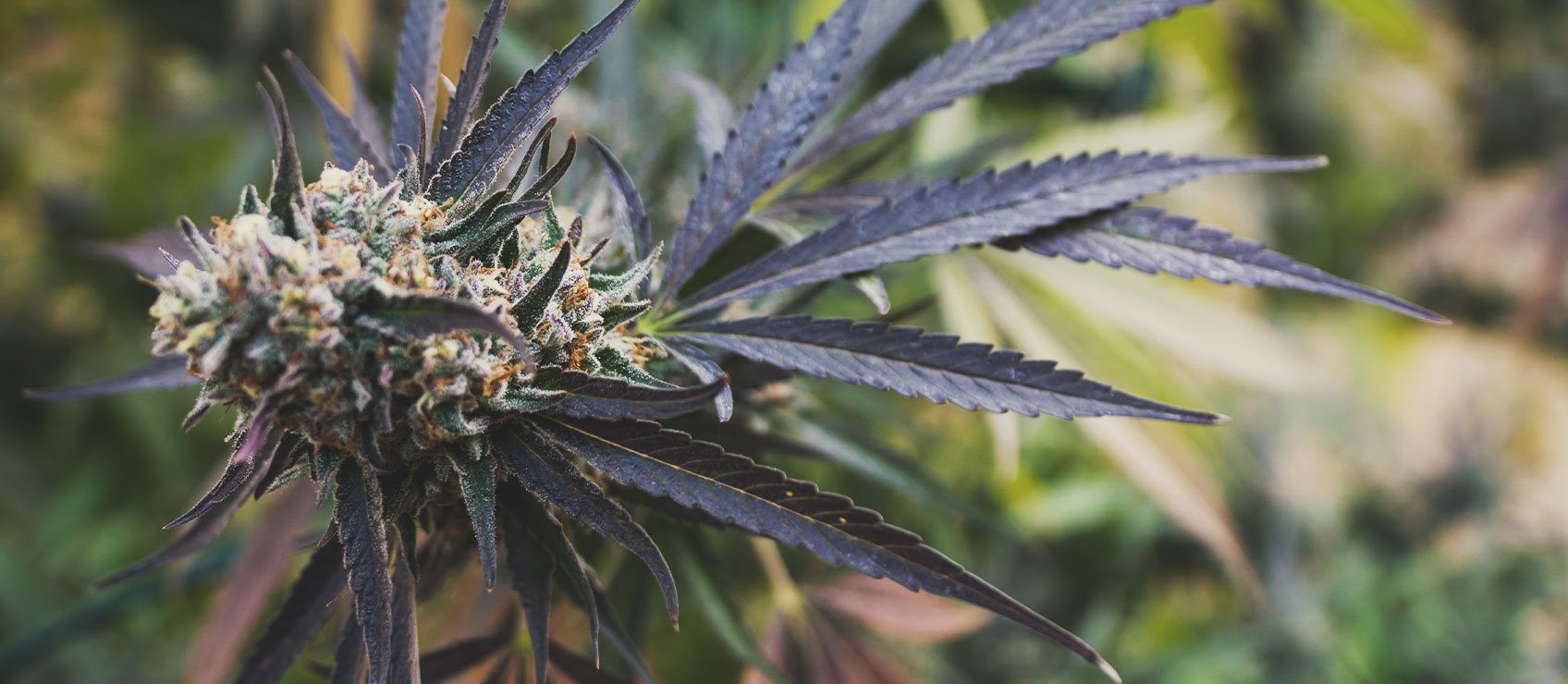
WHITE LEAVES
The leaves of some cannabis strains have a sparkling white appearance due to layers of milky trichomes covering them. In those cases, it’s a sign of good-quality bud. However, there are also cases where white leaves are due to something serious.
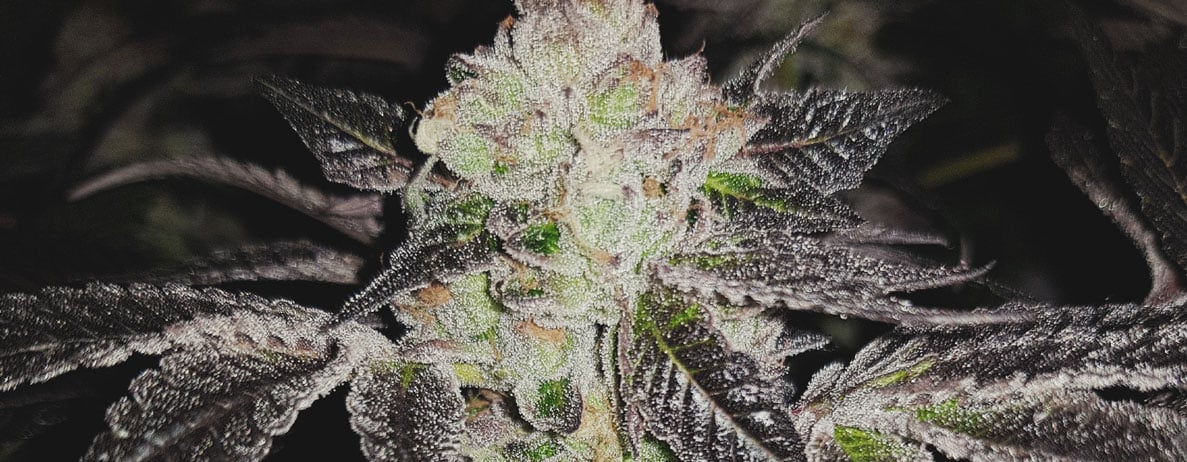
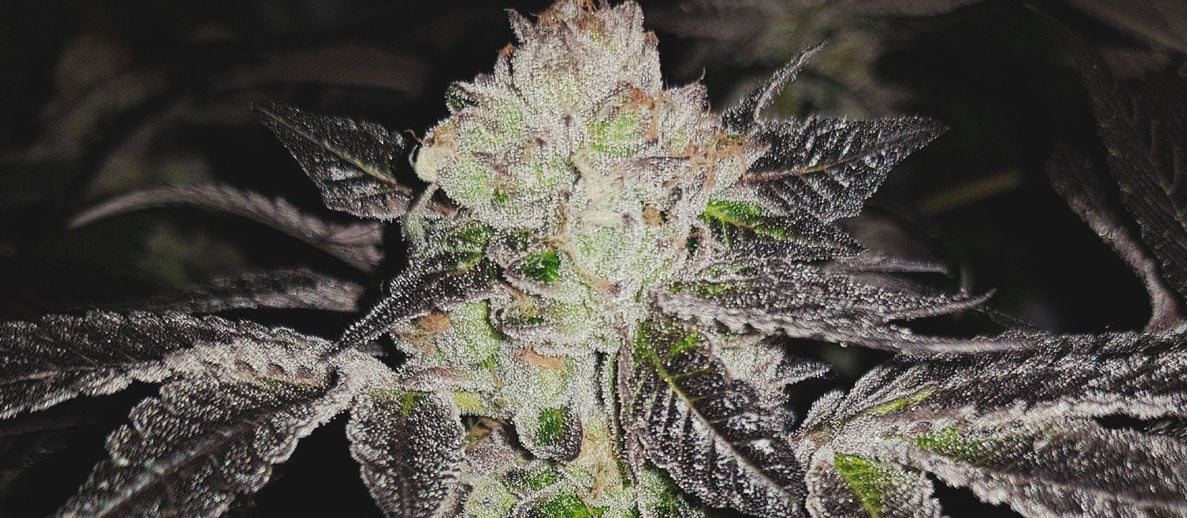
POWDERY MILDEW
Powdery mildew is a layer of white, powdery mould on the leaves of cannabis. It may appear as white spots or bumps, and it may look like patches of flour on the leaves. If left untreated, powdery mildew can cause serious damage to your plants.
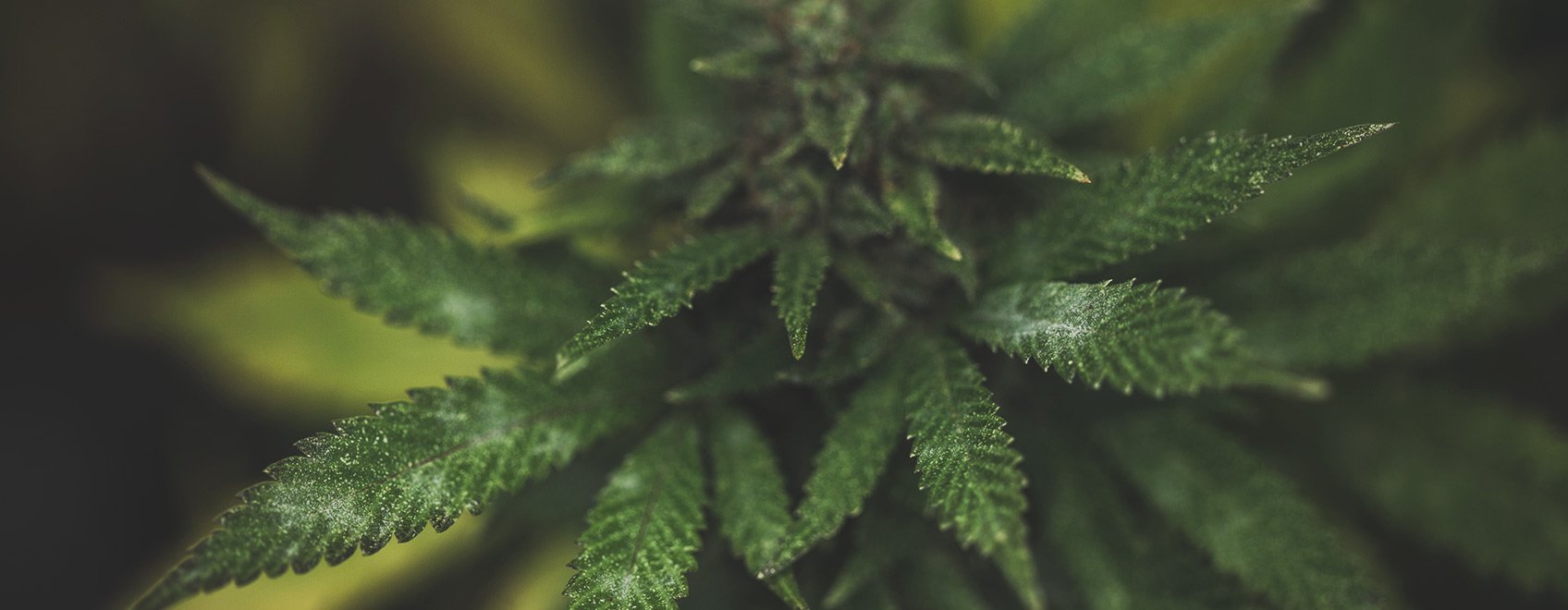
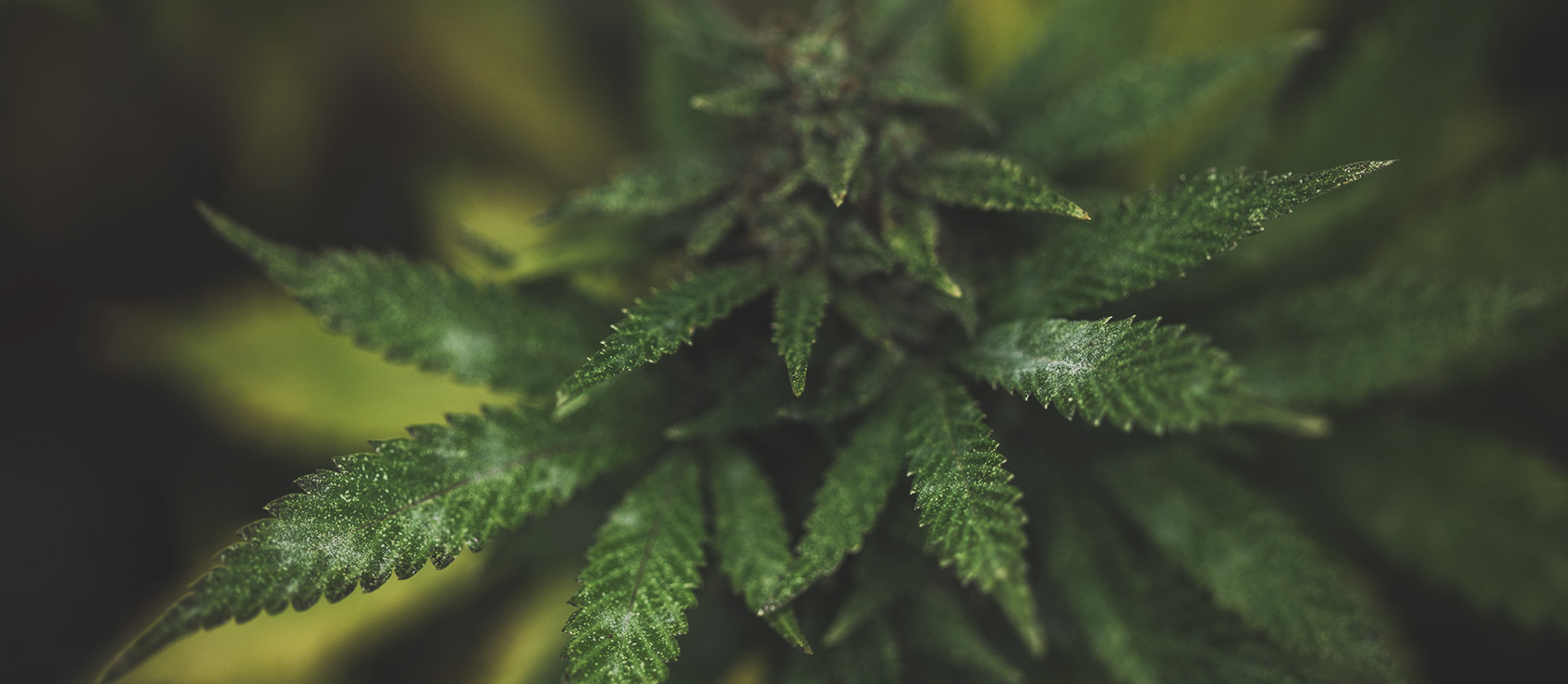
| How to prevent |
|
| How to fix |
|
| How to prevent |
|
| How to fix |
|
Holes and discolouration
If you spot holes in the leaves, or notice irregular spots and leaf discolouration, pests may be your problem. A keen eye, along with a jeweller’s loupe, will help you spot them before they can do more damage.
LEAF MINER LARVAE
Leaf miner larvae “tunnel” through the leaves, leaving characteristic yellowish or white marks resembling the shape of a worm.
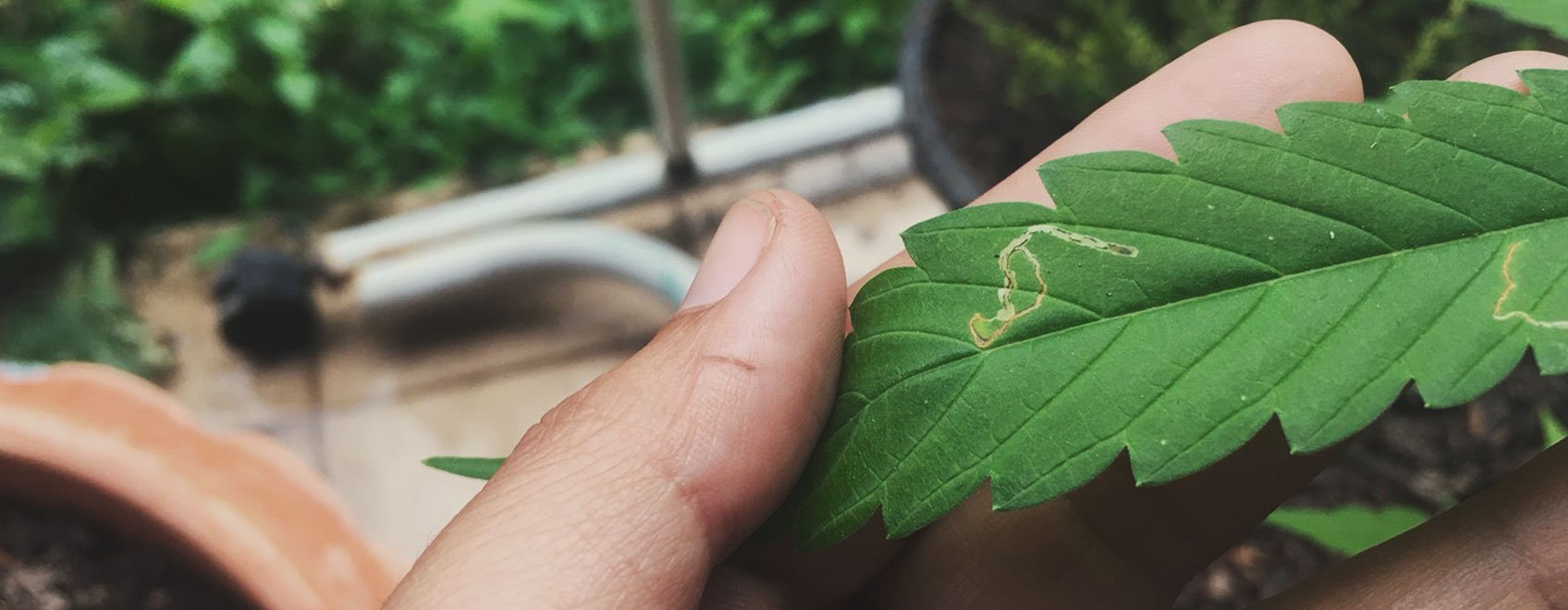
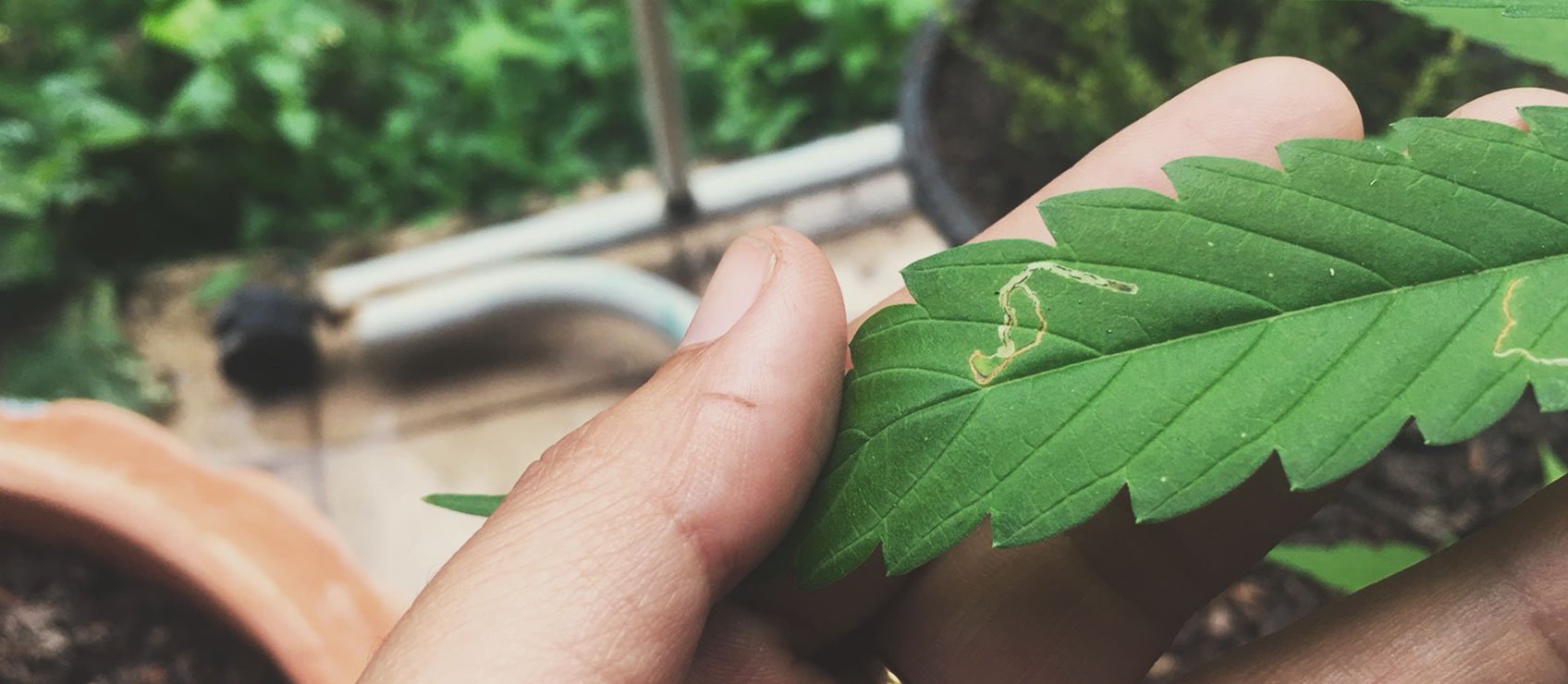
| How to prevent |
|
| How to fix |
|
| How to prevent |
|
| How to fix |
|
CATERPILLARS
Caterpillars, as they do with other plants, will eat large holes in your buds and leaves.
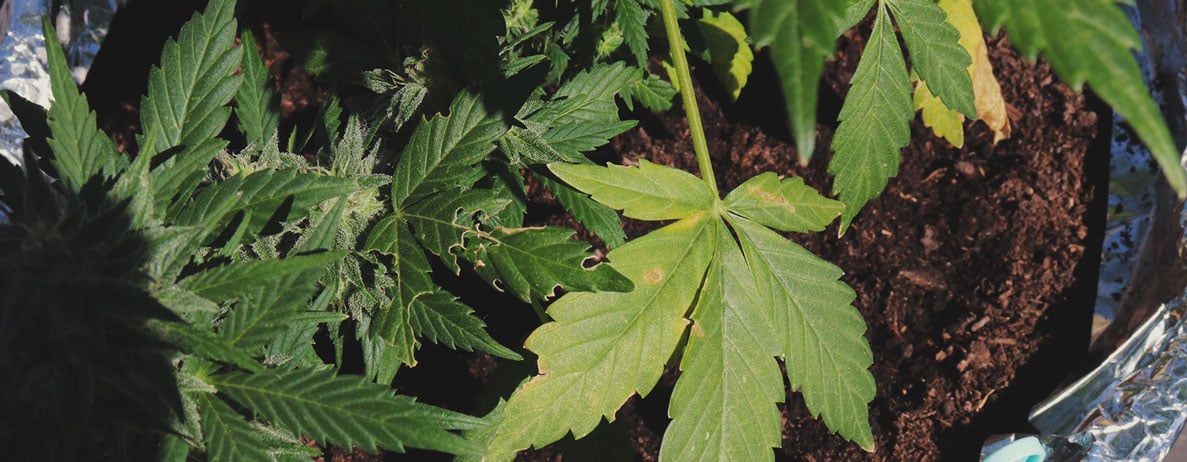
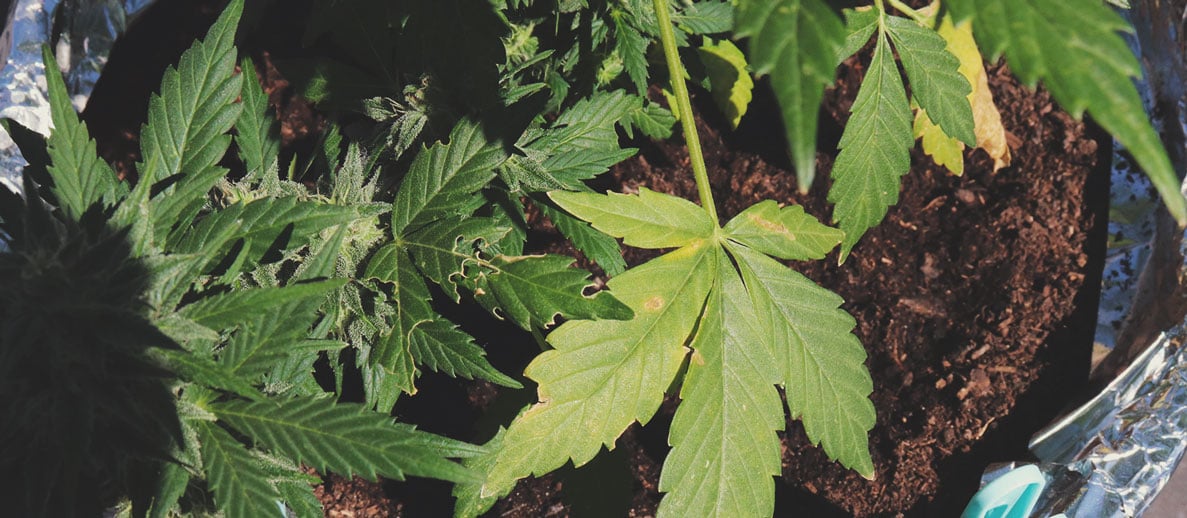
| How to prevent |
|
| How to fix |
|
| How to prevent |
|
| How to fix |
|
THRIPS
Thrips are small dark or yellowish insects. The larvae, or nymphs, may look like tiny worms. They feed on chlorophyll and cause extensive irregular yellow/white spotting on cannabis leaves.
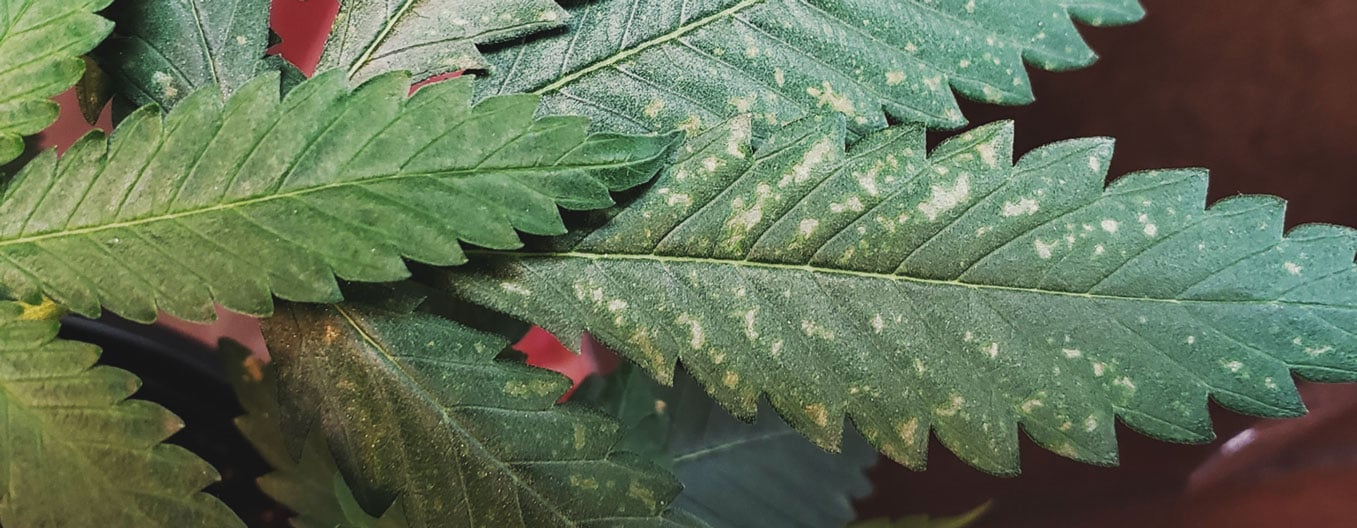
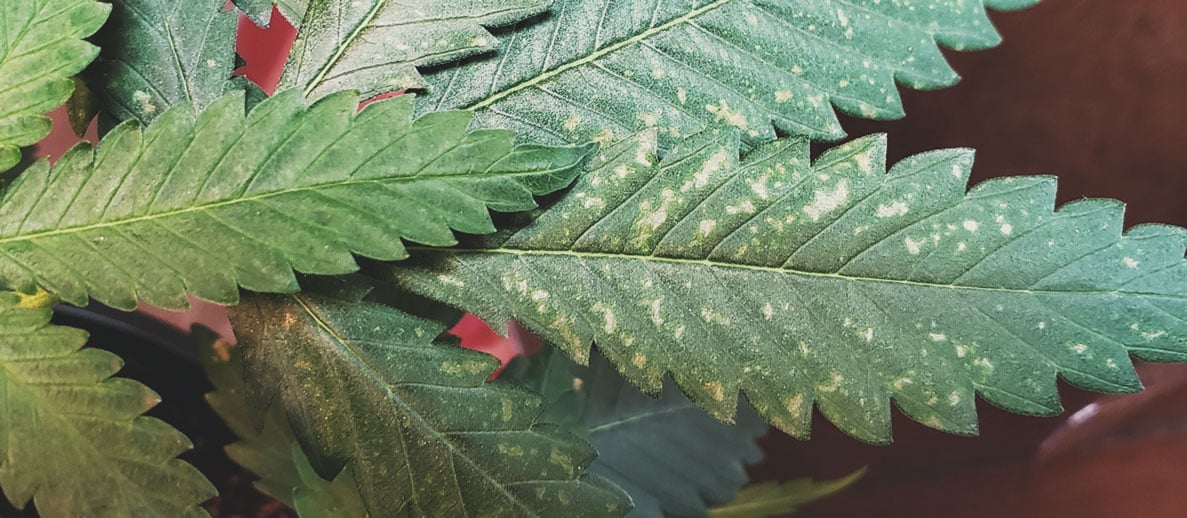
| How to prevent |
|
| How to fix |
|
| How to prevent |
|
| How to fix |
|
APHIDS
Along with thrips, aphids are the most common cannabis pests. These tiny sap-sucking insects come in various colours, and are some of the most destructive cannabis pests out there. You’ll need to use a jeweller’s loupe to see them! Signs of an infestation include yellowing, spotting, and speckles on the leaves.
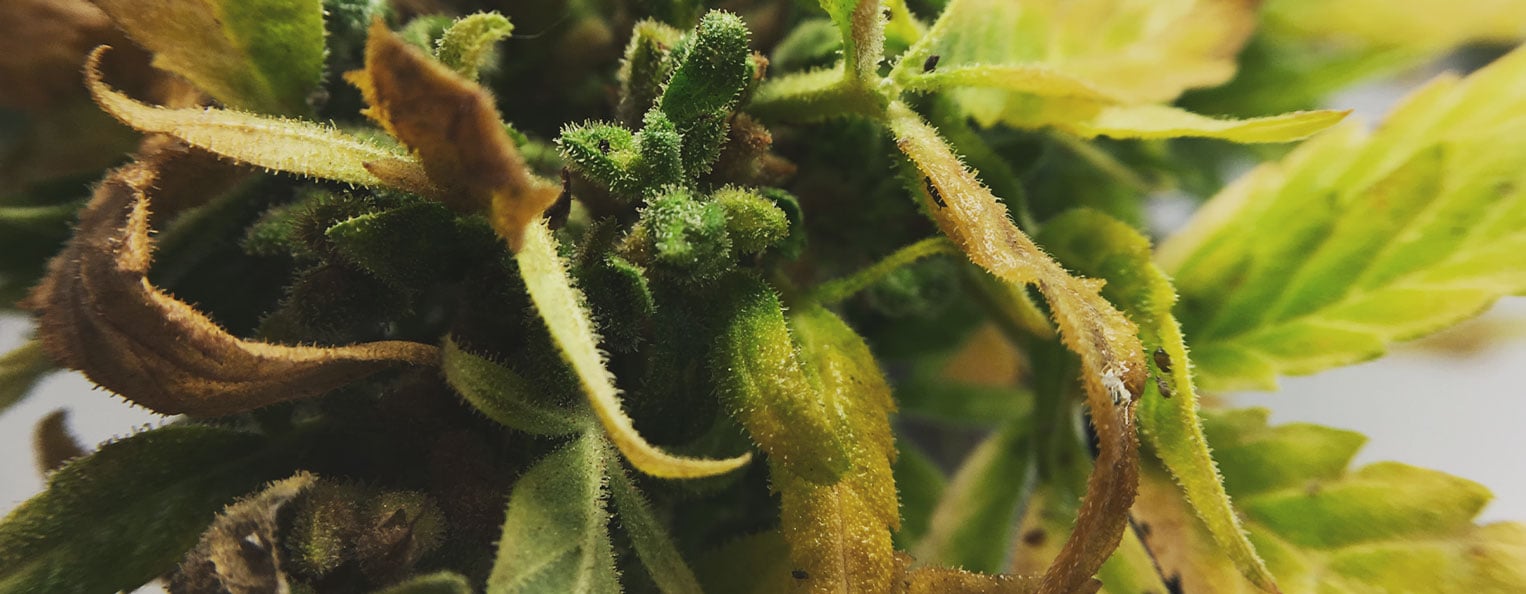
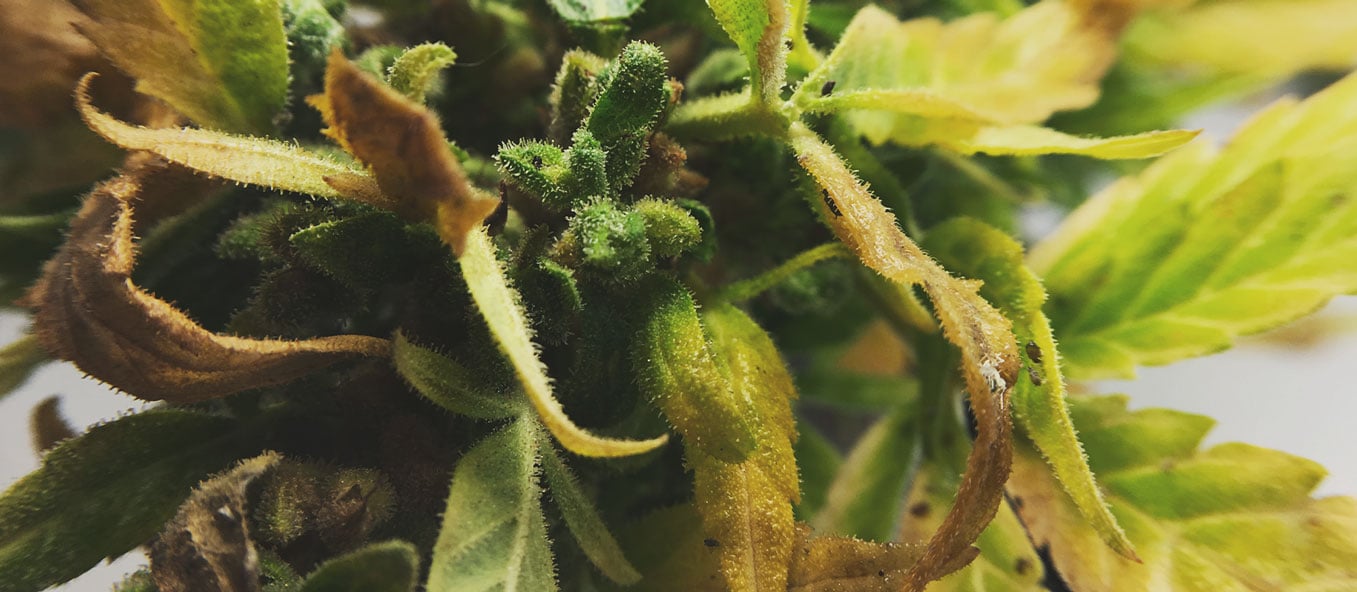
| How to prevent |
|
| How to fix |
|
| How to prevent |
|
| How to fix |
|
REVEGETATION
When the flowering period of photoperiod cannabis is interrupted or halted, usually due to light issues, it reverts back to the vegetative stage. This “re-vegging” causes significant plant stress and leads to odd growing patterns with unusual leaf shapes.
Revegetation can happen by accident, but it can also be intended. A technique called monster cropping, for instance, involves re-vegging plants for a second harvest.
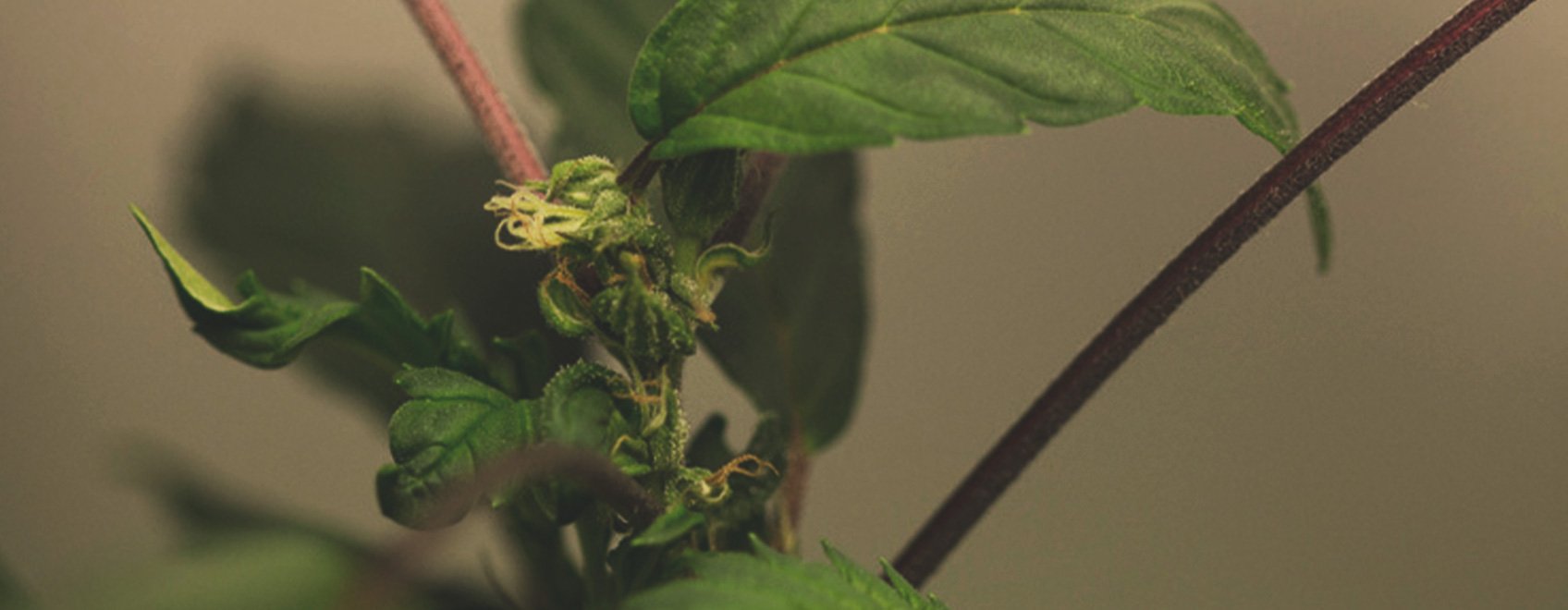
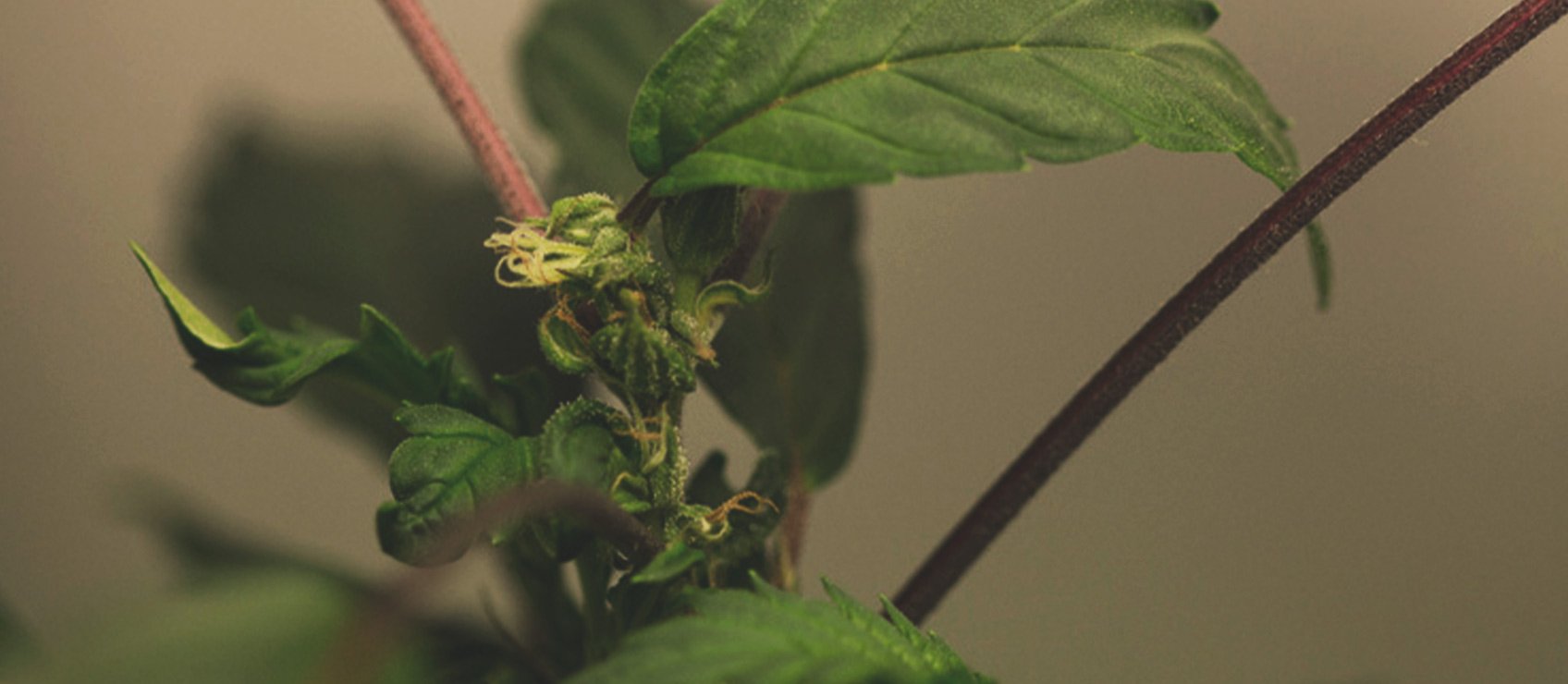
| How to prevent |
|
| How to fix |
|
| How to prevent |
|
| How to fix |
|
Weird patterns and patches
There can be various other reasons why cannabis leaves show unusual patterns instead of an even green colour.
TOBACCO MOSAIC VIRUS
Chief among these reasons, according to some, is the tobacco mosaic virus. It’s a disease sometimes seen in tomatoes and other vegetable crops, but opinions differ on whether TMV can infect cannabis.
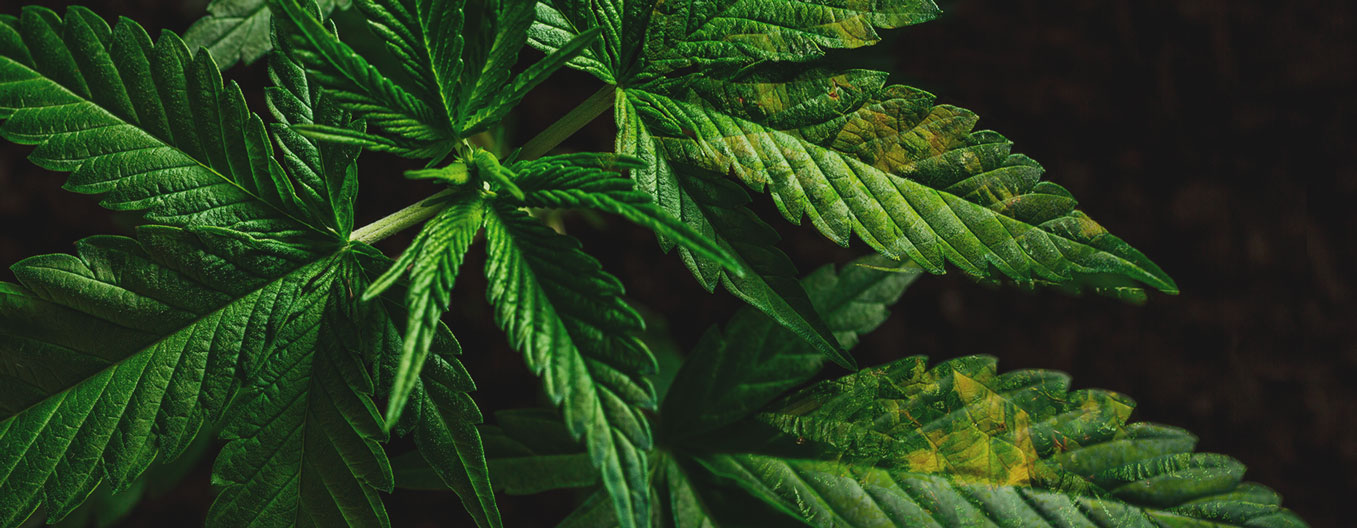
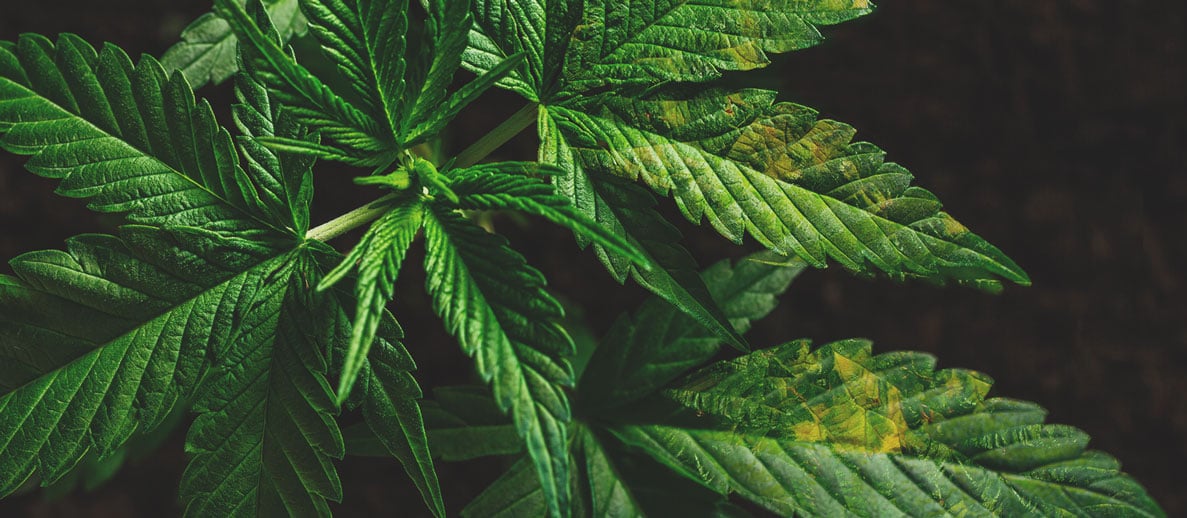
| How to prevent |
|
| How to fix |
|
| How to prevent |
|
| How to fix |
|
MUTATIONS
Cannabis, like other plants, can display mutations on the leaves. Some of these mutations are initiated by breeders to better camouflage the plant or make it less identifiable as marijuana; other times, mutations are a minor defect inherent to some strains.
Apart from the common, gnarly-looking sets of leaves that appear on young plants, widespread leaf mutations, like even numbers of fingers or ugly deformities, are very rare. Excessive mutations are indicative of bunk genetics and poor breeding practices.
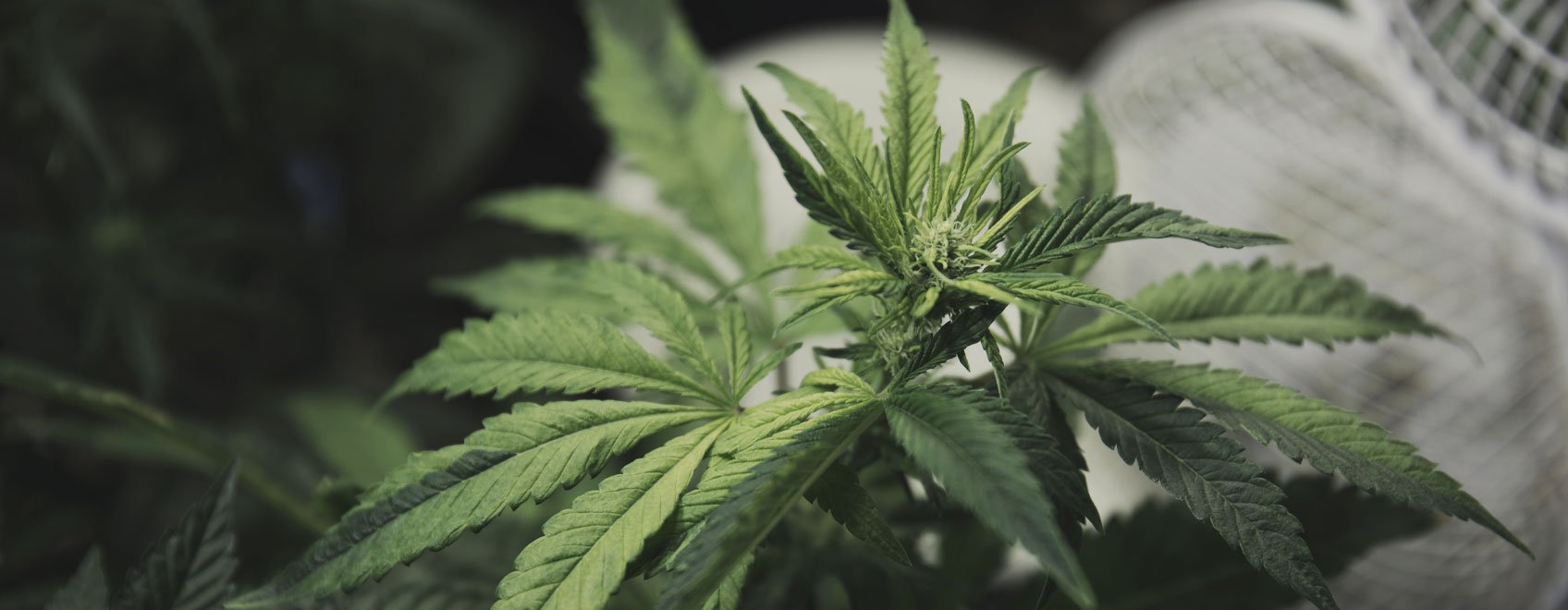
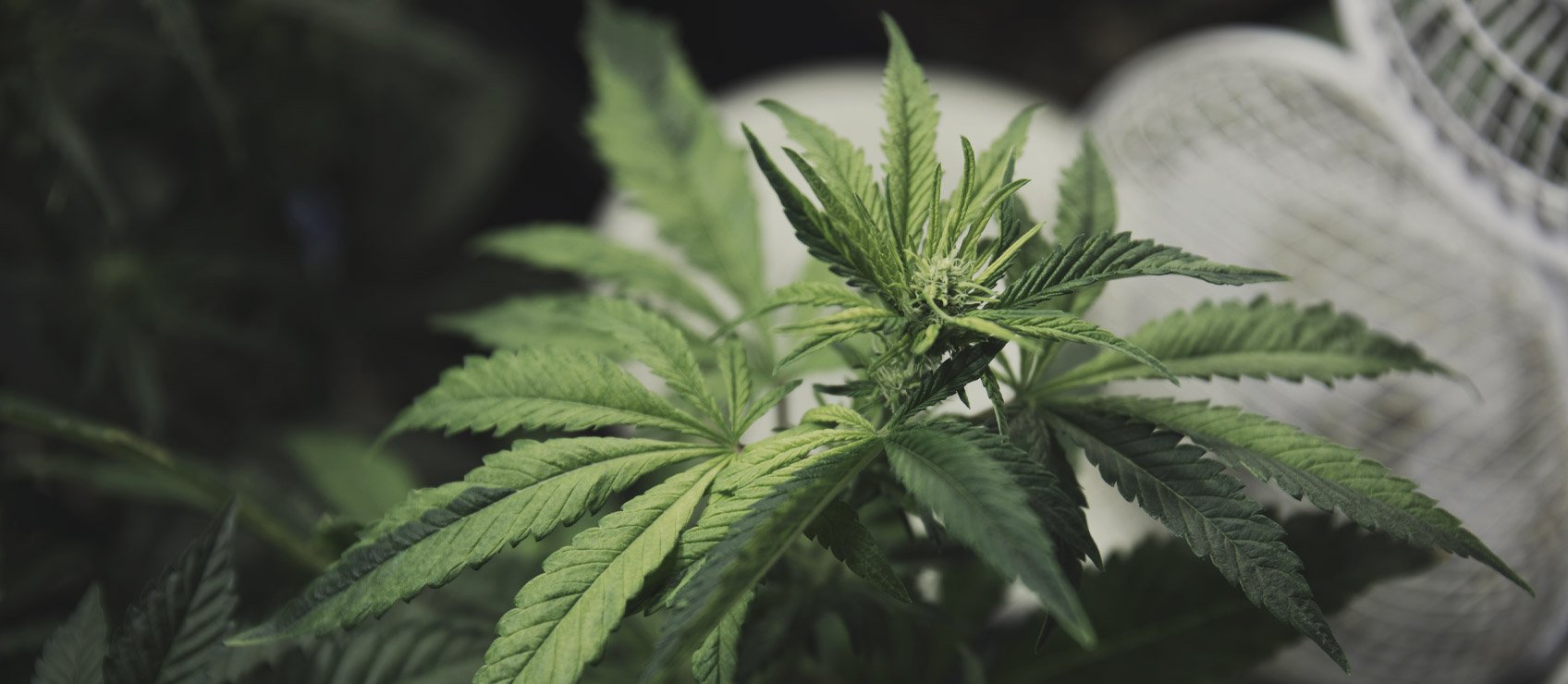
ALBINO
Albinism is an extremely rare mutation in cannabis. With white leaves and white buds, these plants are mostly a curious novelty. Rather than peculiar appearances, growers are usually more concerned with bud quality, taste, and potency.
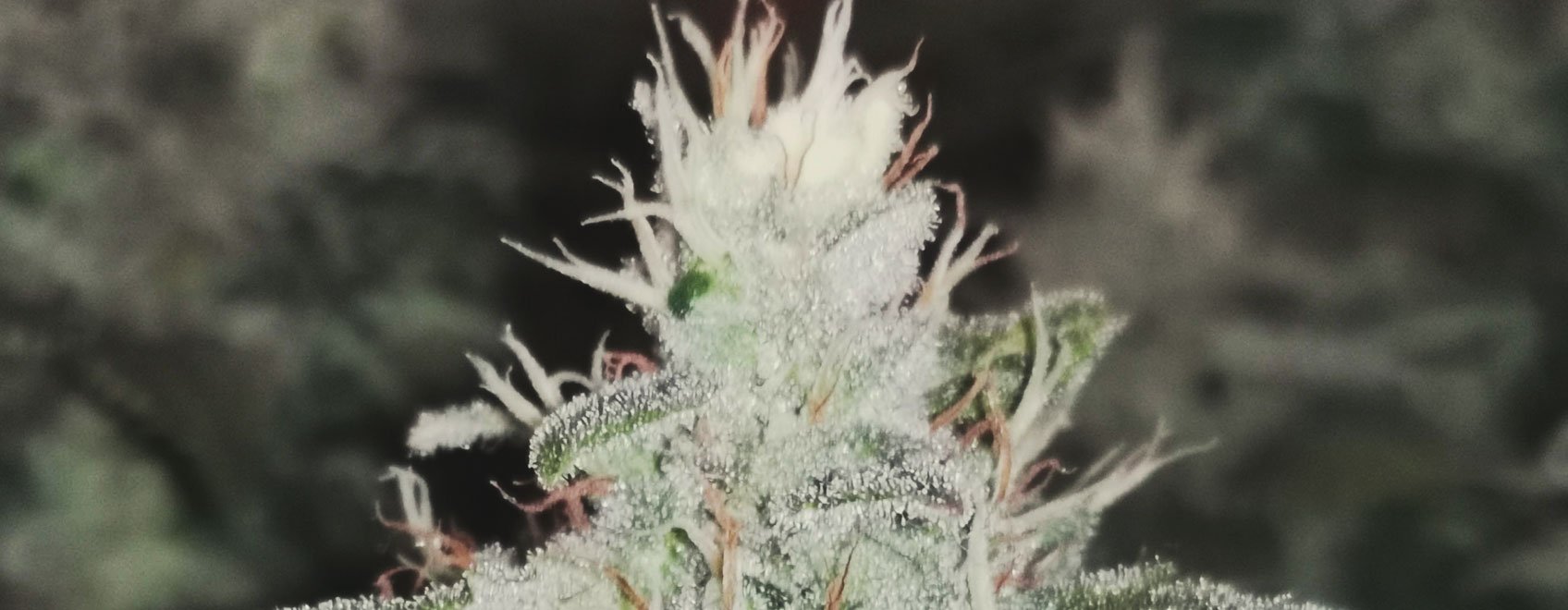
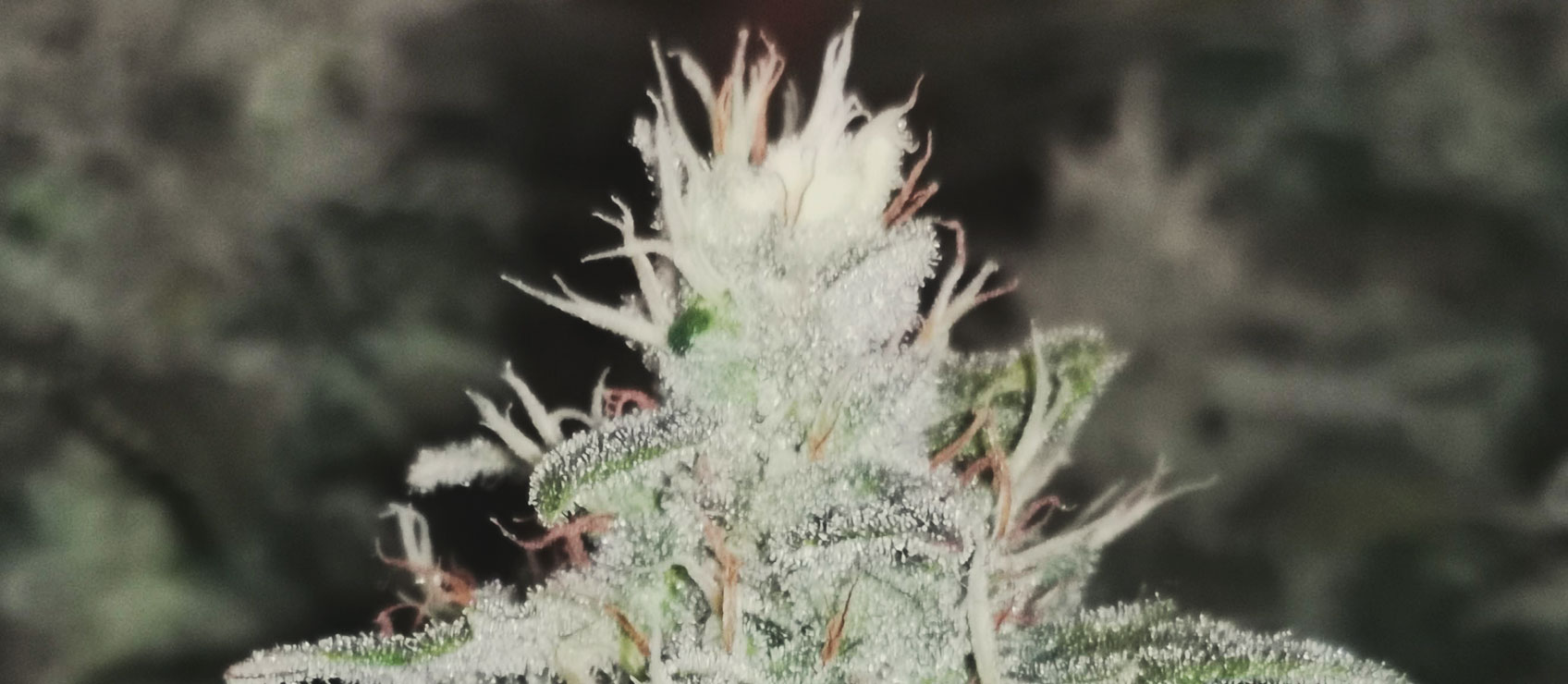
LEAF BUDS
This is a rare mutation where the buds don’t emerge at the nodes where the stalks originate. Instead, they grow directly on the centre of the leaves. As these “leaf buds” are tiny, most cultivators remove them before they take up too much nutrients.
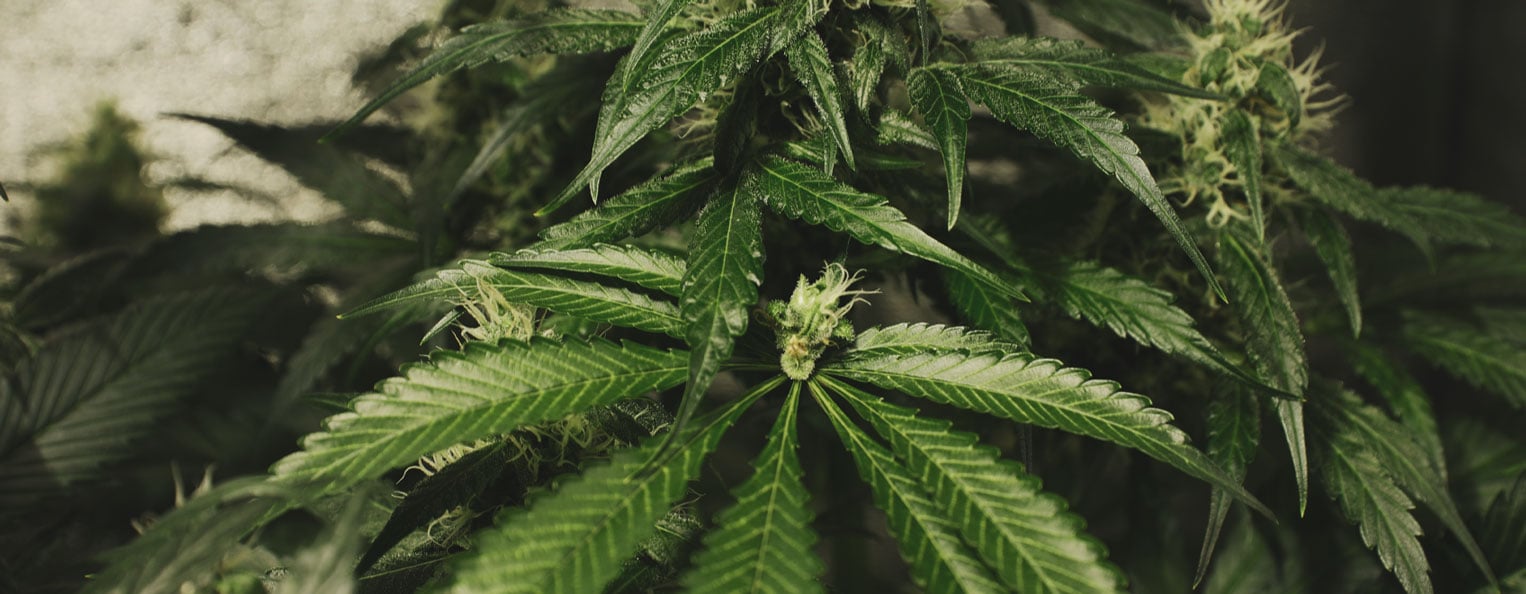
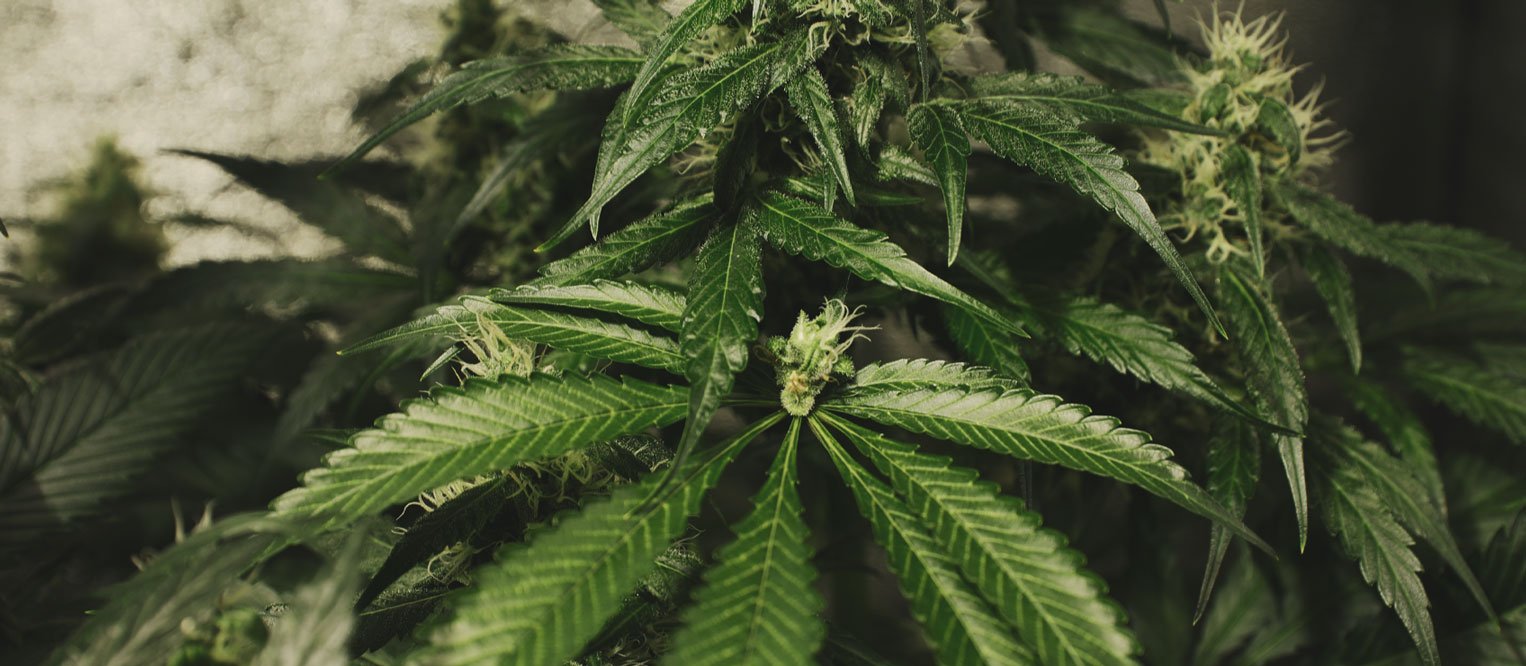
| How to prevent |
|
| How to prevent |
|
FOLIAR SPRAYING
Some cannabis issues, as we’ve mentioned here and there, can be fixed with foliar spraying. The spray makes direct contact with the leaves themselves, making it the quickest way to provide nutrients to cannabis plants.
What Can Be Done With Cannabis Fan Leaves And Sugar Leaves?
So, what use do the leaves have beyond indicating disease?
Well, although the fan leaves contain only trace amounts of THC or CBD, there are several ways they can be effectively repurposed. To start, cannabis fan leaves can be juiced alongside other healthy ingredients to take advantage of a host of nutrients and cannabinoid acids. While the fan leaves won’t get you high, they will contribute to a healthy diet. Alternatively, for a super-light buzz, you can make fan leaf tea. Add a little coconut oil to allow the cannabinoids to bind to the fat, and you’ll have a nice soothing beverage to enjoy.
The fan leaves are also ideal for making cannabis ointments and salves. If you have enough leaves, you can successfully extract the cannabinoids and filter out excess plant matter to create your own homemade skincare line. Finally, fan leaves can simply be added to a compost pile to support your next grow. After all, what’s better than growing cannabis with cannabis leaf compost?
And don’t forget; sugar leaves can be put to good use too! Although they’re widely considered too harsh for smoking, their heavy trichome load makes them perfect for rendering into hash or cannabutter. Unlike fan leaves, sugar leaves are more packed with cannabinoids, so you can achieve quite the buzz off sugar leaf hash if you have enough raw material.
Essentially, all parts of the cannabis plant can be put to good use. No need to waste anything!
What Can Leaf Colour Tell You About THC And CBD Levels?
We know that the colour and shape of leaves can tell a story. They inform us of a plant's genetics, sugar levels, hydration, nutrient status, and even what kinds of pests have been gnawing away at them.
Interestingly, the colour and shape of cannabis leaves may also inform us of the kinds of cannabinoids they’re producing. It is theorised that lighter shades of green and thinner leaflets point to higher levels of CBD, whereas thicker leaflets and darker shades of green hint at higher levels of THC.
-
Research shows leaves can tell us about the chemicals within cannabis
These findings stem from a research paper[1] published in the journal HortScience. The authors of the paper start out by challenging the idea of “indica” and “sativa” classifications. Although these categories have no basis in science, it turns out it may be possible to judge the chemical composition of a cannabis plant by the way it looks.
The researchers investigated the visual variations among a total of twenty-one different cannabis strains. Overall, they identified and measured thirty variations during the vegetative and flowering stages, and during harvest.
After categorising the plants based on the way they looked, they carried out a chemical analysis to see what cannabinoids each plant was producing. Interestingly, they found a consistent correlation between the way each plant looked and whether they were high in THC, CBD, or contained moderate levels of both cannabinoids.

-
High-CBD plants
Plants with high levels of CBD displayed shades of light-green and possessed thinner leaflets (the "fingers" of cannabis leaves) and a higher number of primary and secondary serrations (the razor-like shapes on the side of the leaflets). These plants also possessed more dense and resinous trichomes, and an increased resistance to Botrytis cinerea—a fungal plant pathogen.

-
Plants with moderate levels of CBD and THC
Plants that contained moderate levels of both CBD and THC also showed unique colours and shapes. These plants featured deep-green shades and medium-wide leaflets. They possessed more primary and secondary serrations, less dense and resinous trichomes, and less resistance to Botrytis.

-
High-THC plants
Finally, the high-THC plants had leaves with a dark shade of green, wide leaflets, dense and resinous trichomes, and susceptibility to Botrytis.
Based on their findings, the authors concluded that these visual markers can serve as a preliminary means of identifying the difference between chemovars (chemical varieties) before conducting chemical analysis.

- Identification of Phenotypic Characteristics in Three Chemotype Categories in the Genus Cannabis in: HortScience Volume 56 Issue 4 (2021) https://journals.ashs.org
 Grow Guide Topic Finder
Grow Guide Topic Finder
- Growing cannabis step by step
- Cannabis growing basics
- Choosing your seeds
- How to germinate seeds
- The cannabis vegetative stage
- The cannabis flowering stage
- Harvesting cannabis
- Trimming, drying, and curing
- Choosing pots and soil
-
Growing indoors
- A Complete Overview Of Growing Cannabis Indoors
- Cannabis Cultivation Tips: How To Set Up Indoor Grow Lights
- How Many Cannabis Plants Can You Grow Per Square Metre?
- Indoor Cannabis Growing: Relative Humidity and Temperatures
- Hydroponics Cannabis Growing Guide (with diagrams)
- Cannabis Micro Growing: Growing Great Weed in Tiny Spaces
- Growing outdoors
- How to grow autoflowering cannabis
- Cannabis nutrients and pH
- Cannabis troubleshooting: Nutrients
-
Cannabis troubleshooting: Growing
- Cannabis Seed Germination — Troubleshooting Guide
- How to Deal With Pythium (Root Rot) in Cannabis Plants
- Slow Cannabis Plant Growth And What You Can Do About It
- How to Prevent and Fix Stretching in Cannabis Seedlings
- Watering Your Cannabis: How to Fix Overwatering and Underwatering
- Understanding Male, Female, And Hermaphrodite Cannabis
- Identifying and Treating Common Cannabis Ailments
- How To Revive a Sick Cannabis Plant
- How to Avoid Mouldy Weed During Drying and Curing
- How to Prevent and Treat Dry and Crispy Cannabis Leaves
- What Cannabis Leaves Can Tell You
- Causes and Solutions for Yellow Cannabis Leaves
-
Cannabis Strains Grow Report
- HulkBerry Automatic Grow Report
- Blue Cheese Auto Grow Report
- Purple Punch Automatic Grow Report
- Triple G Automatic Grow Report
- Do-Si-Dos Automatic Grow Report
- Green Gelato Automatic Grow Report
- Haze Berry Automatic Grow Report
- Purple Queen Automatic Grow Report
- Cookies Gelato Automatic Grow Report
- Sherbet Queen Automatic Grow Report
- Sweet Skunk Automatic Grow Report
- Medusa F1 Grow Report
- Cannabis plant training
-
Weed growing tips
- The Cannabis Plant Anatomy
- How to preserve seeds
- How Much Sunlight Do Outdoor Cannabis Plants Need To Grow?
- How to Control and Prevent Stretching in Cannabis Plants
- My Cannabis Plants Are Growing Too Tall: What Should I Do?
- Should You Worry About Purple Or Red Cannabis Stems?
- What To Do When Your Indoor Cannabis Won’t Flower
- How To Protect Your Cannabis Plants From Heat Stress
- How To Tell If Your Female Cannabis Plant Has Been Pollinated
- Growing Medical Marijuana
- Bud Washing: How to Clean Your Weed
- Understanding Cannabis Yield per Plant










































